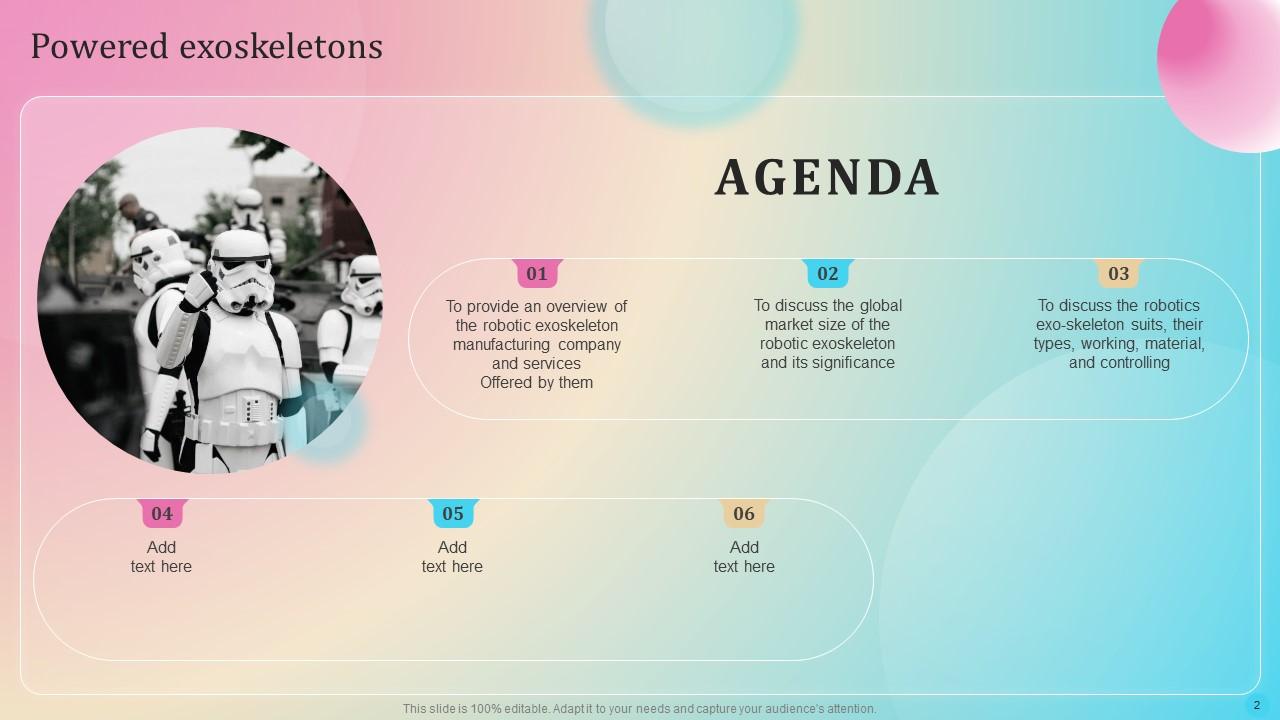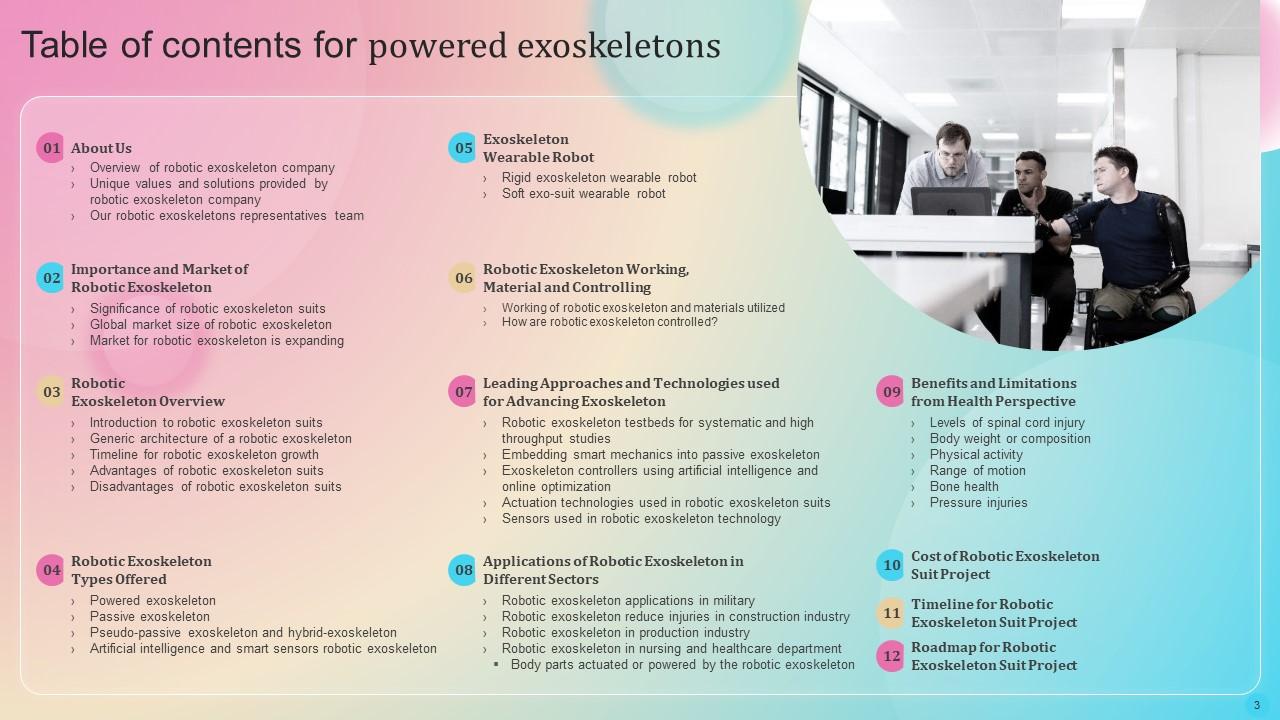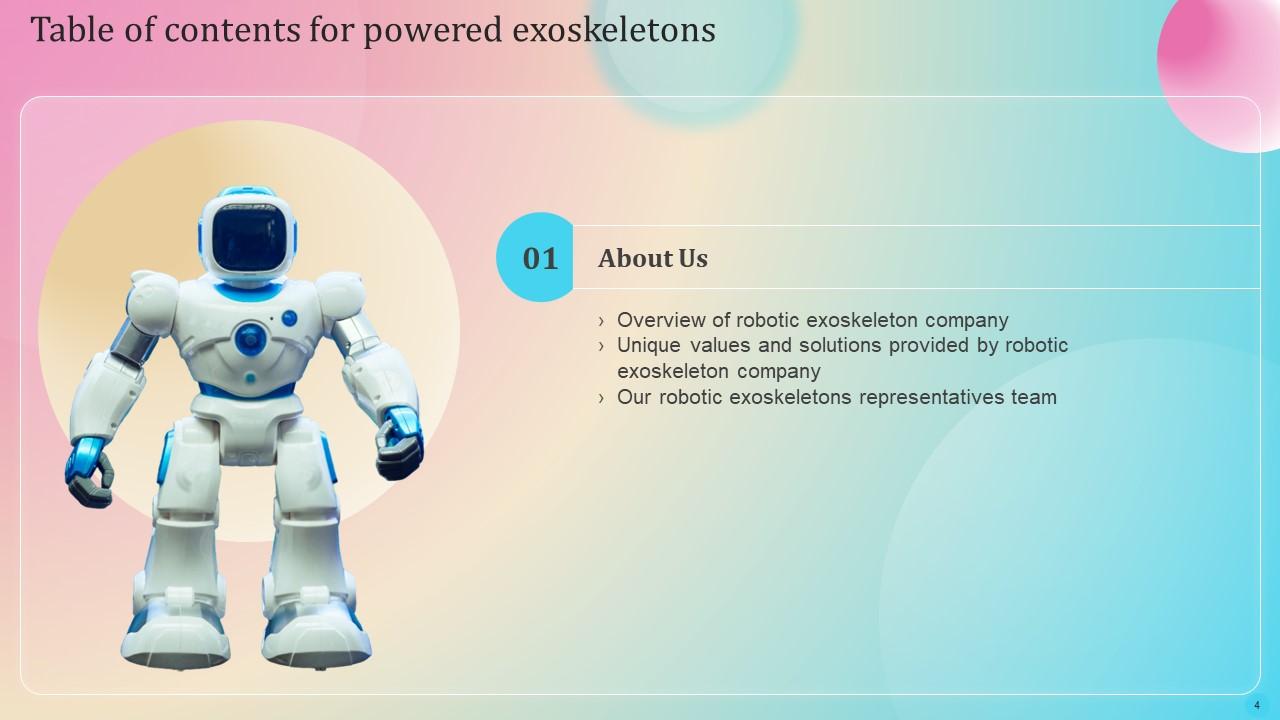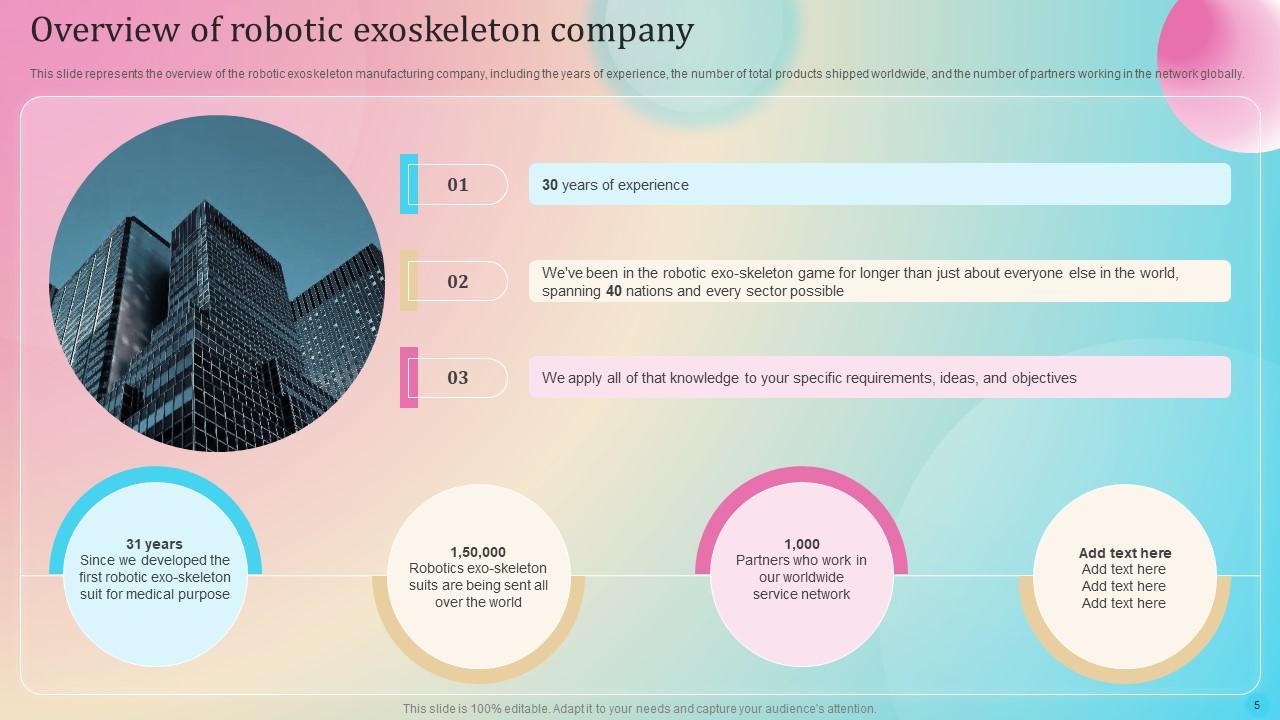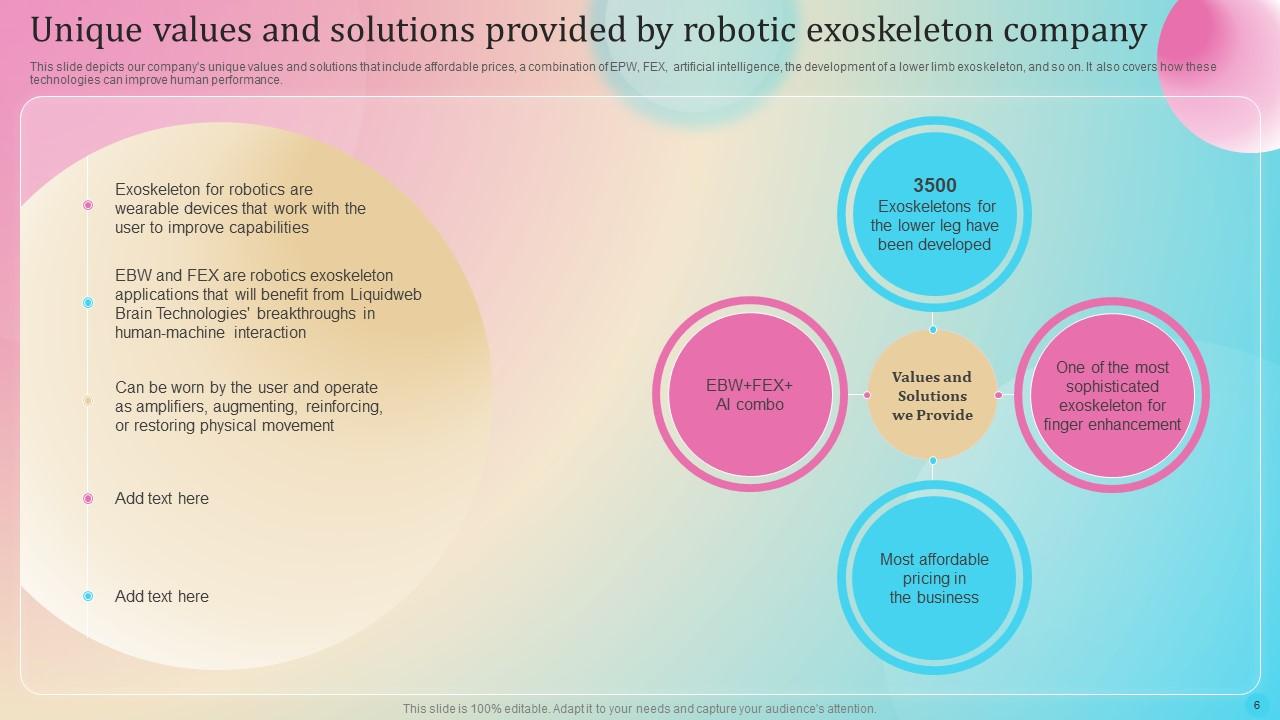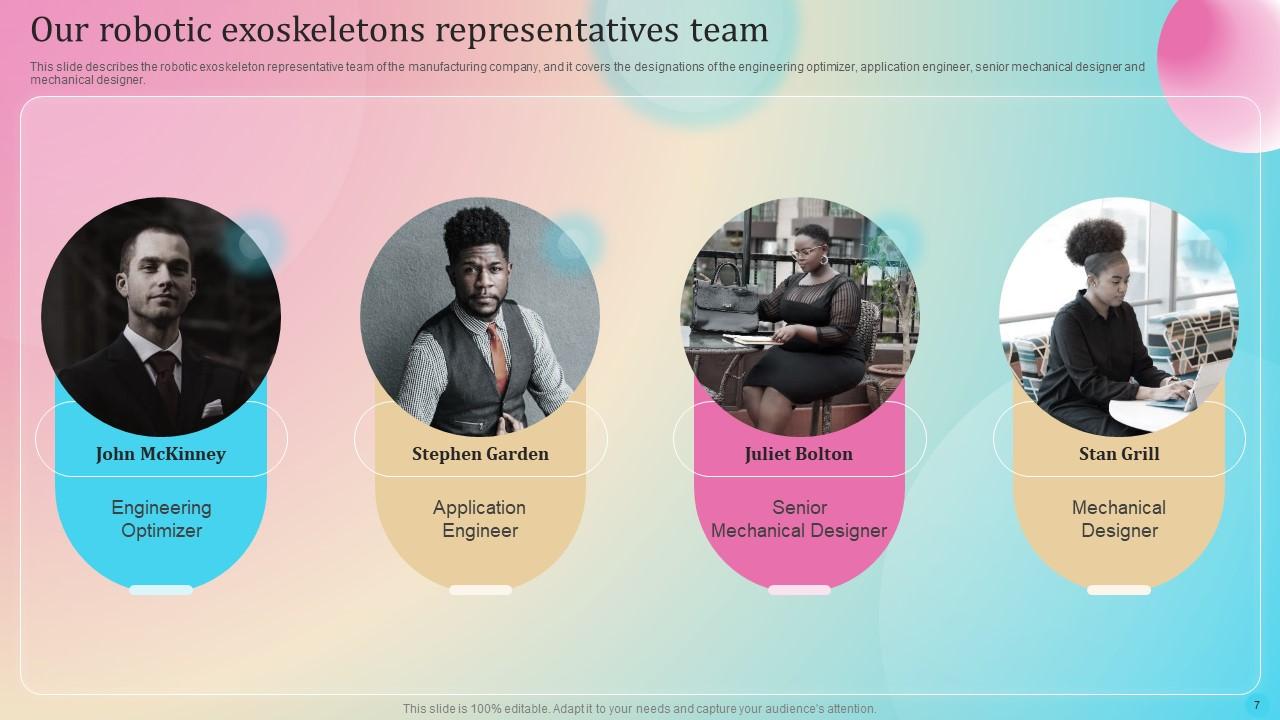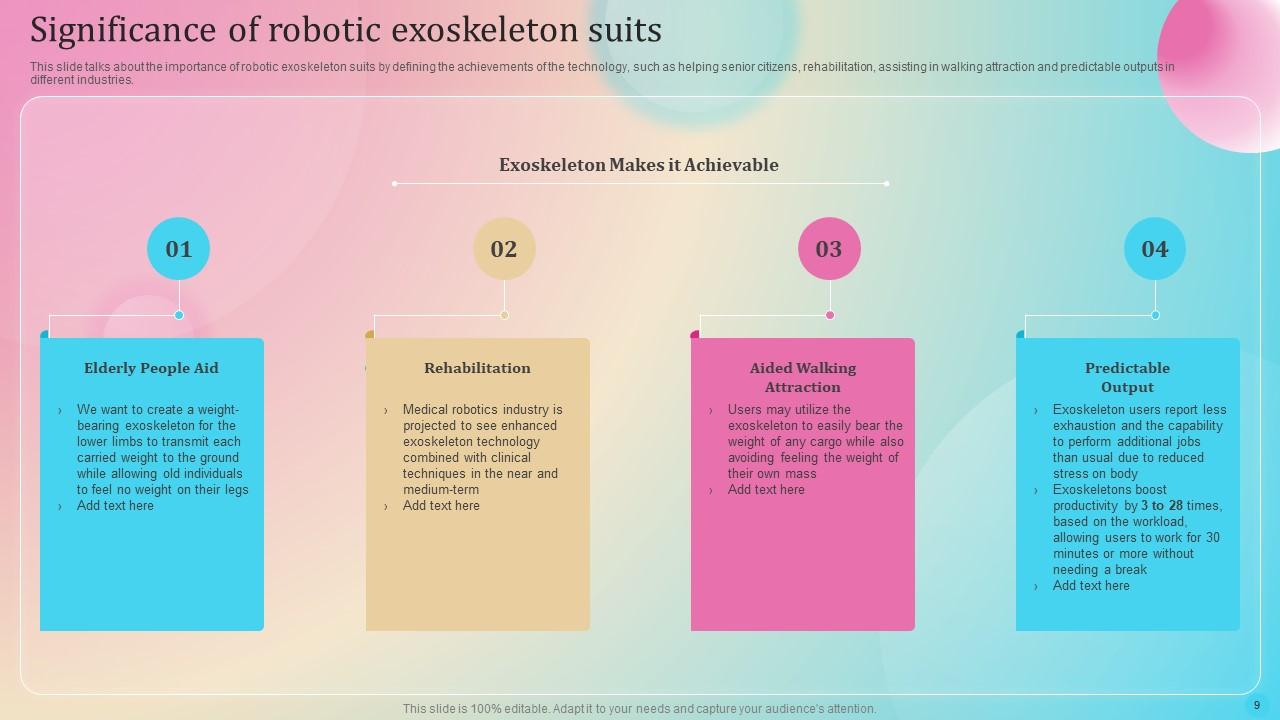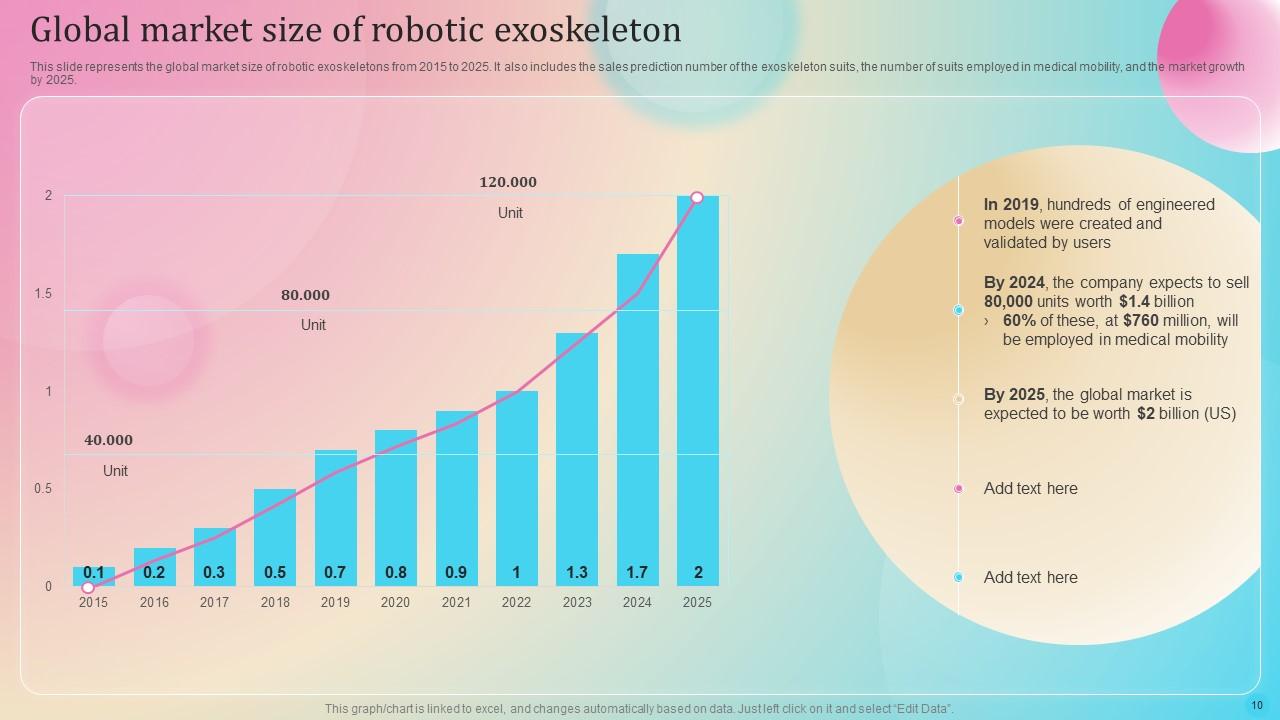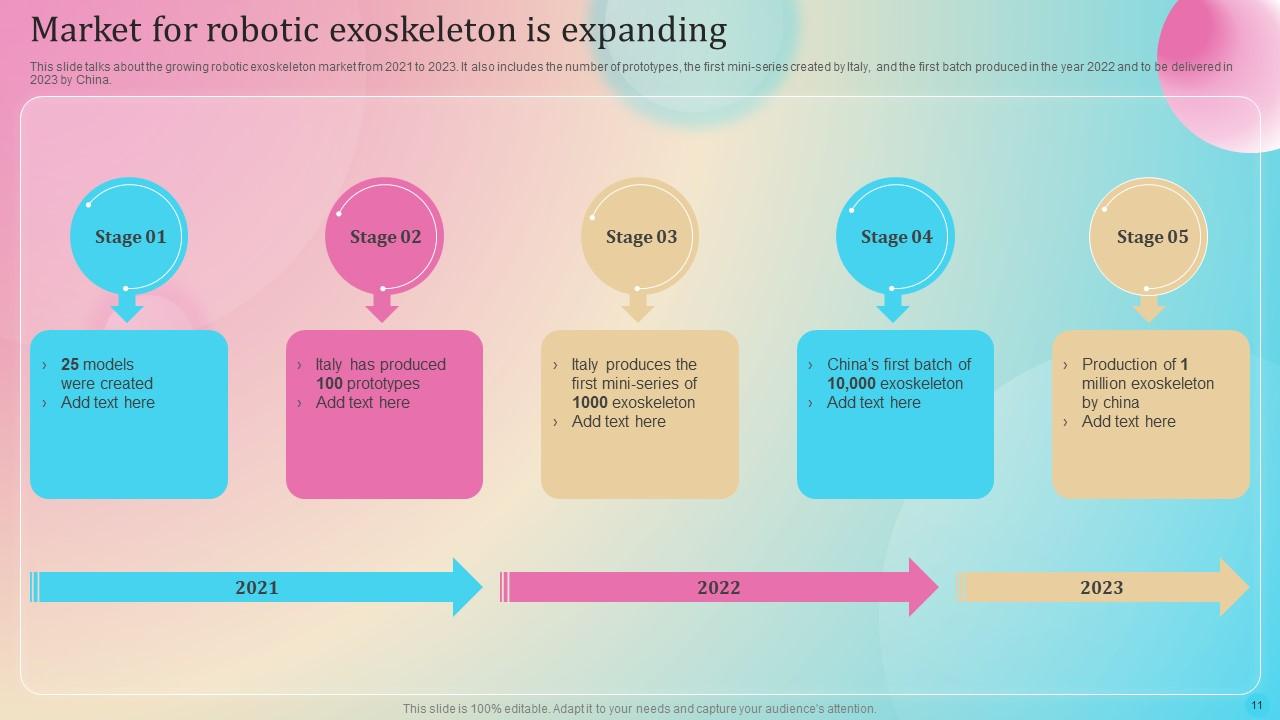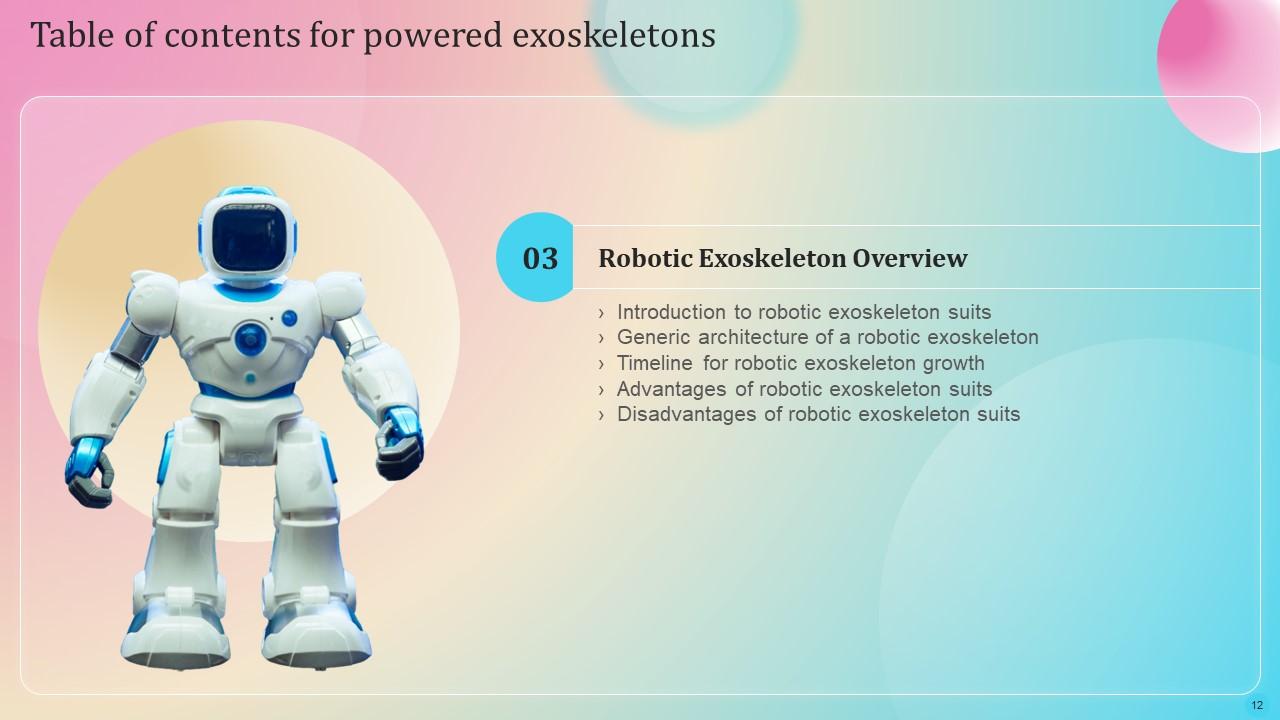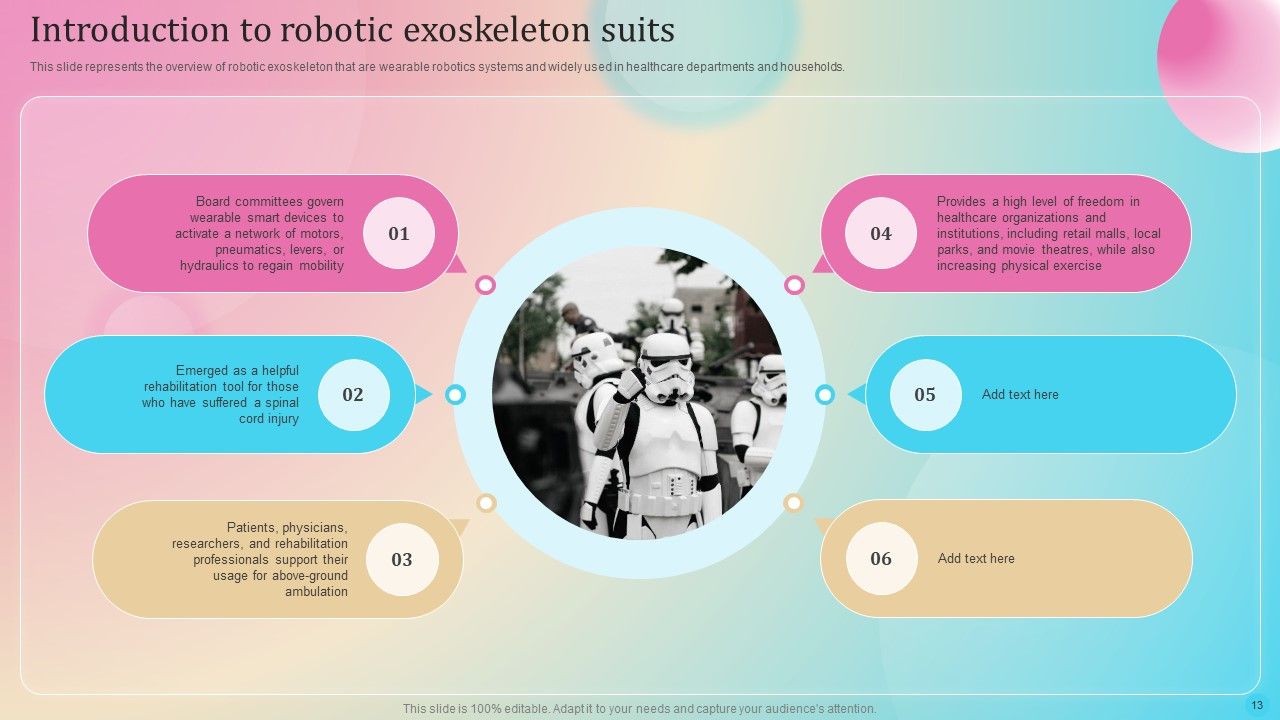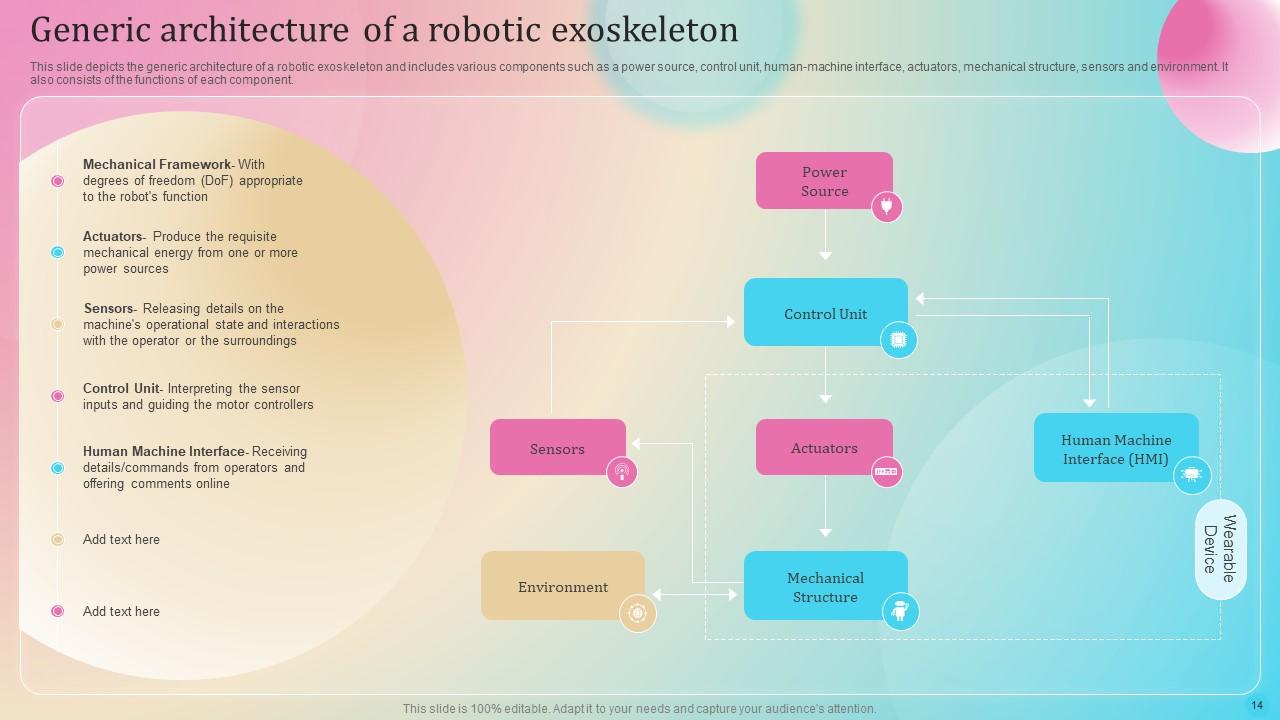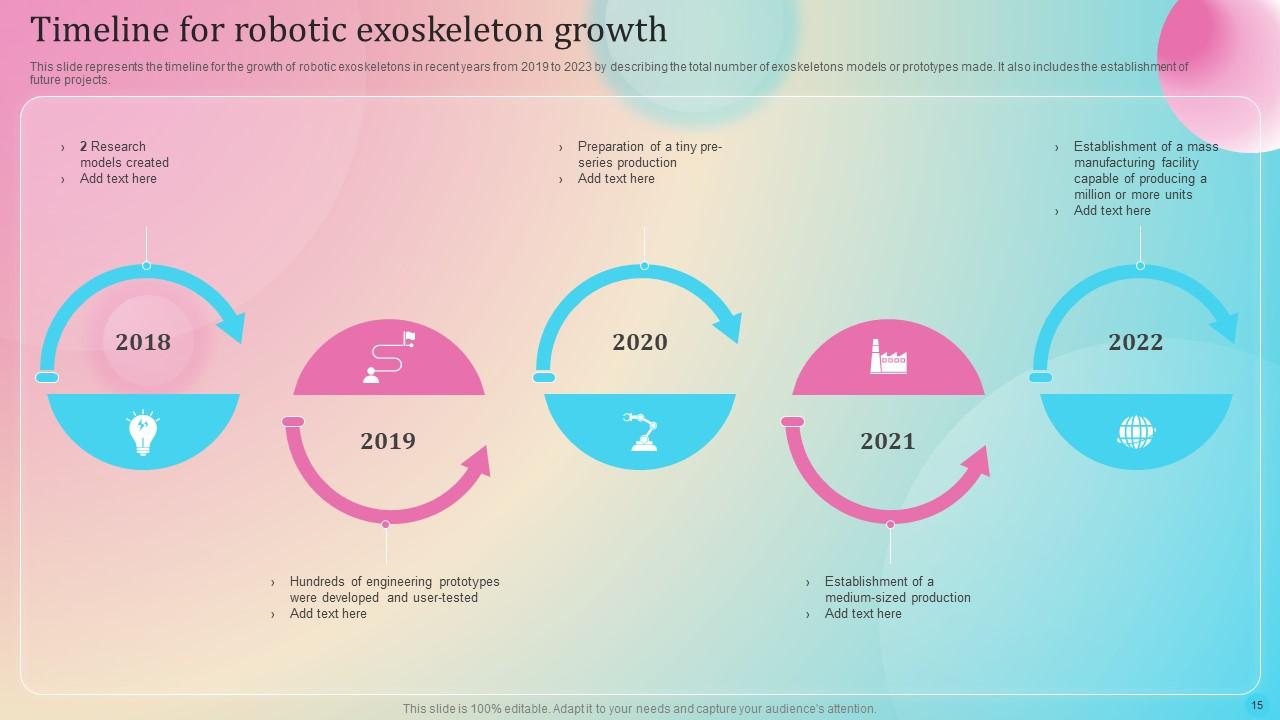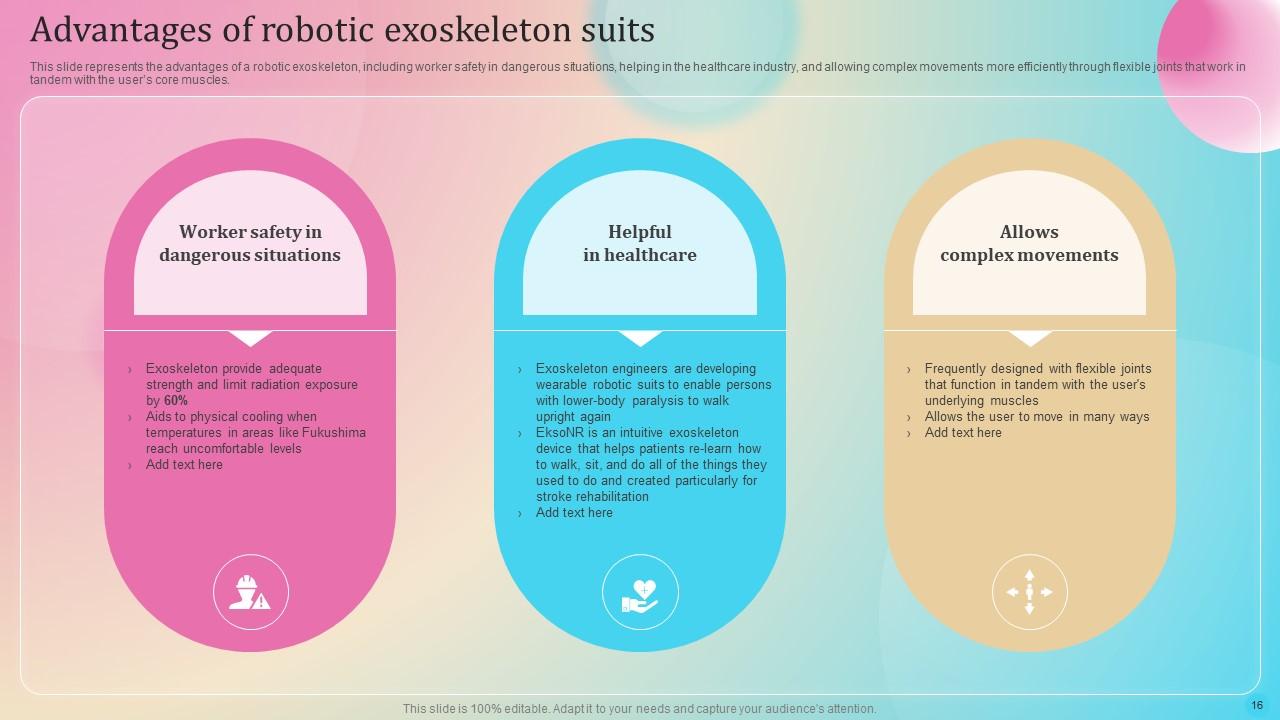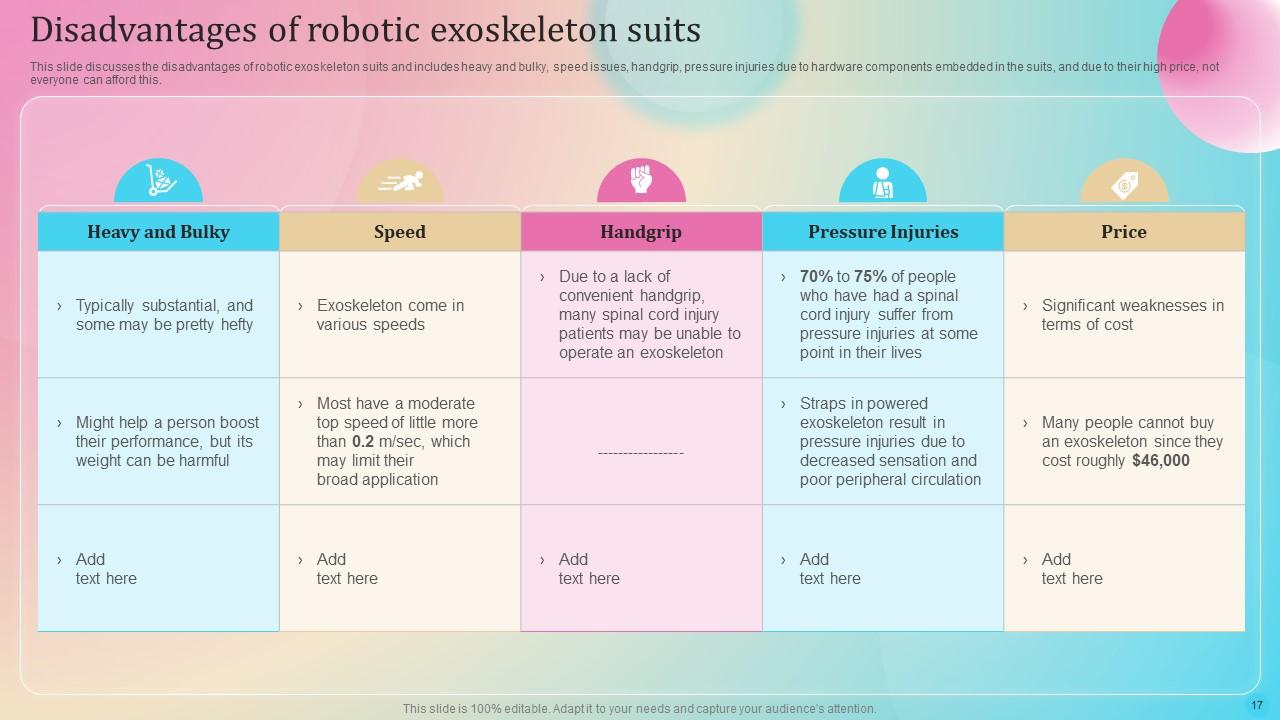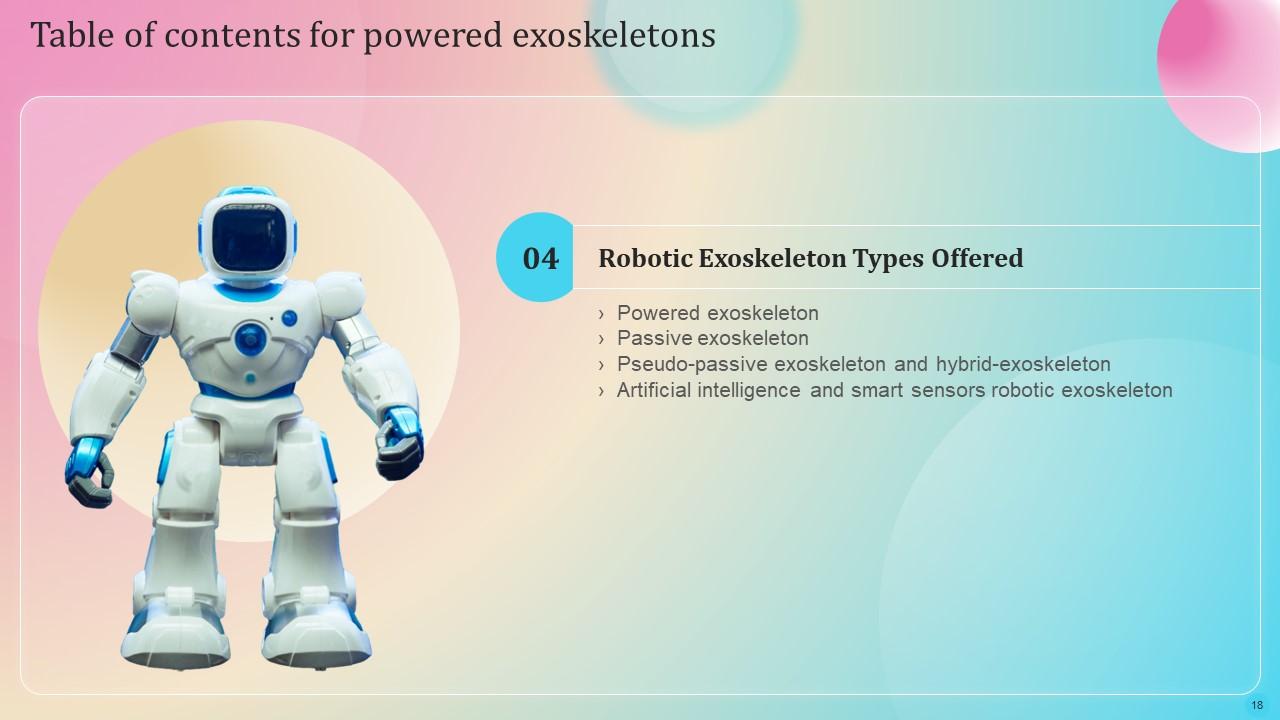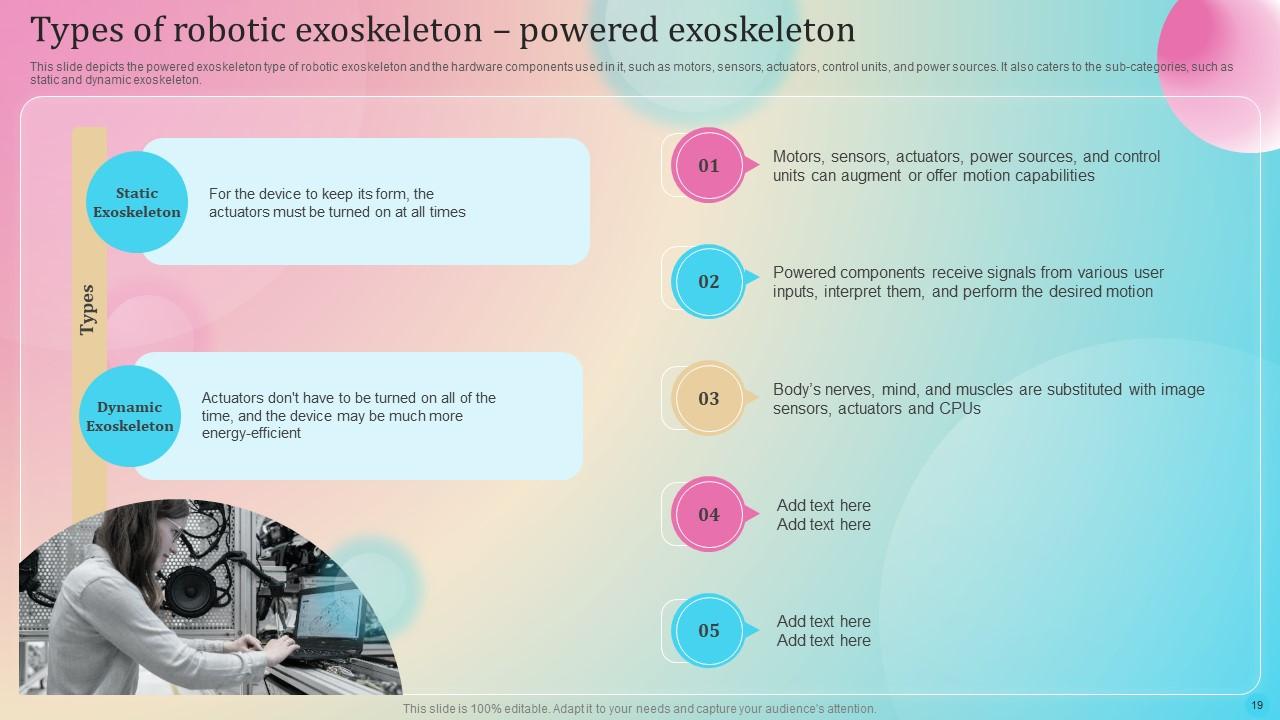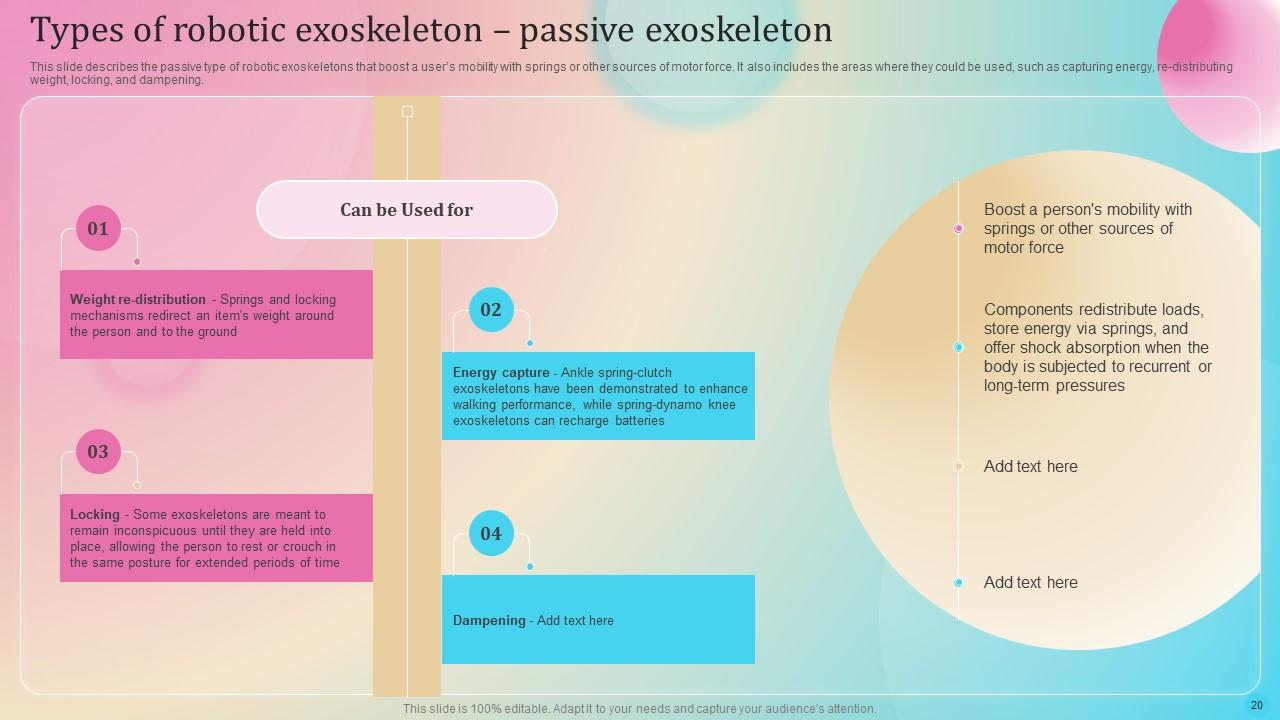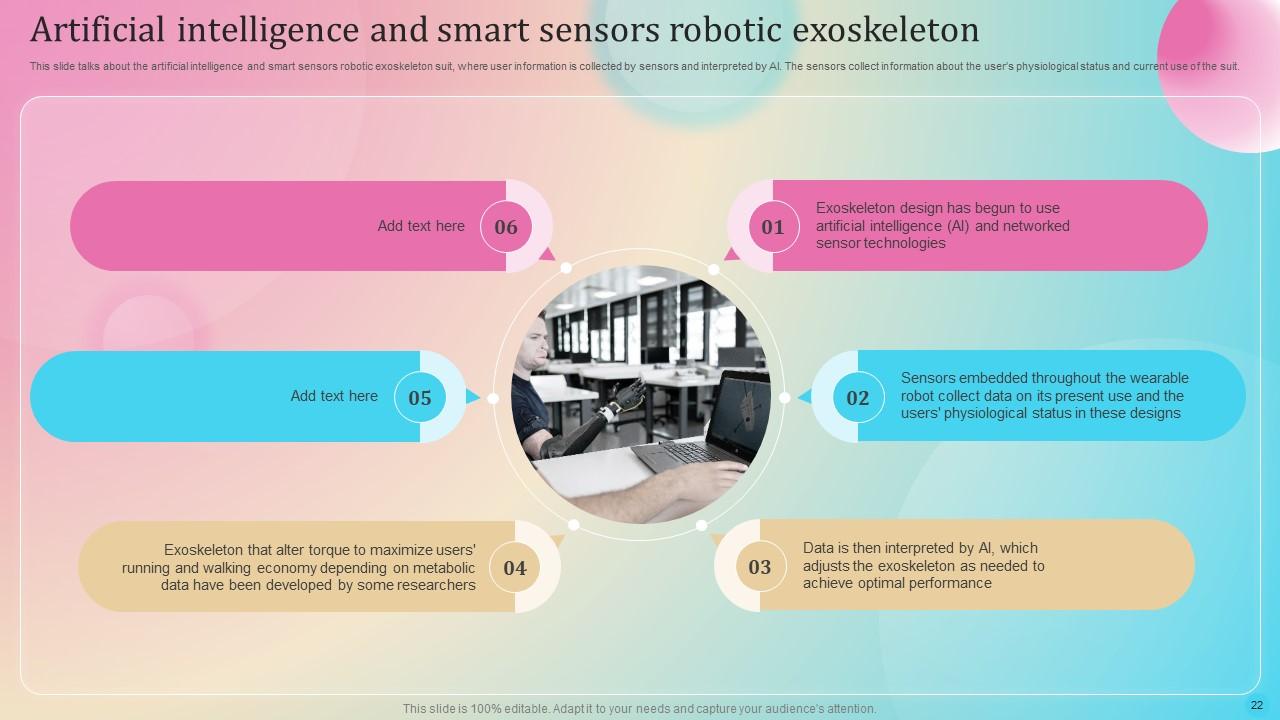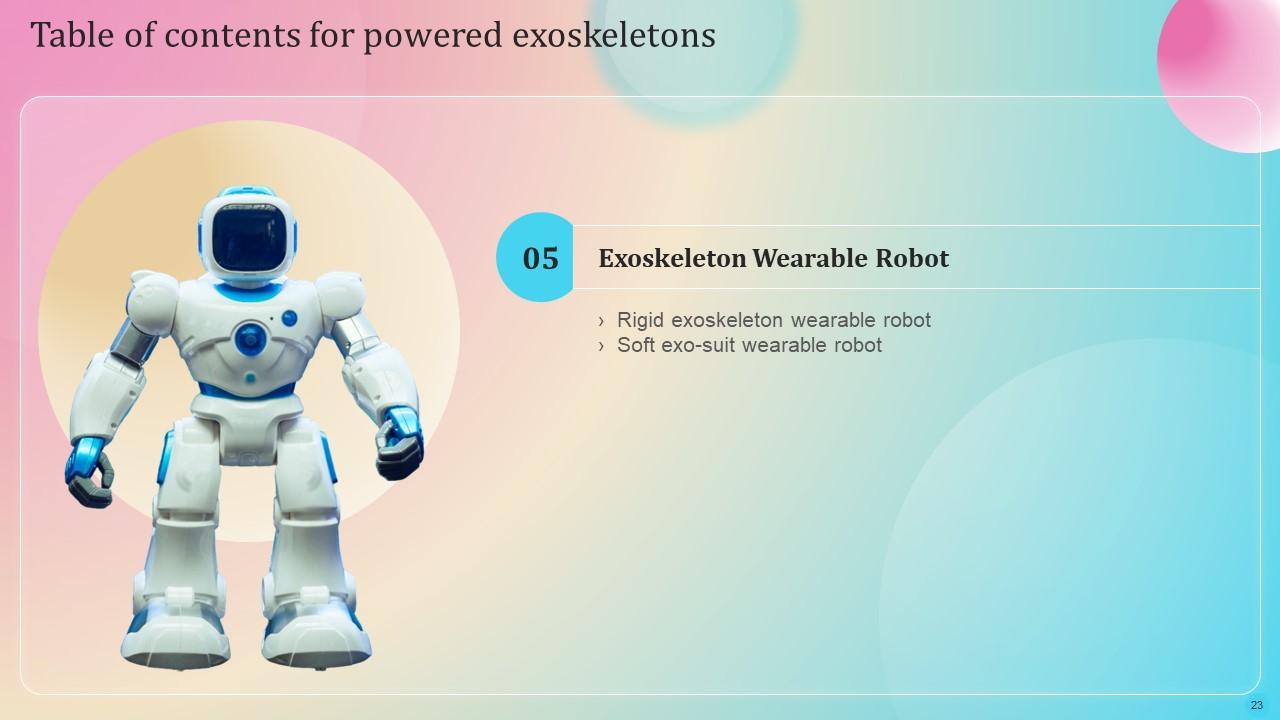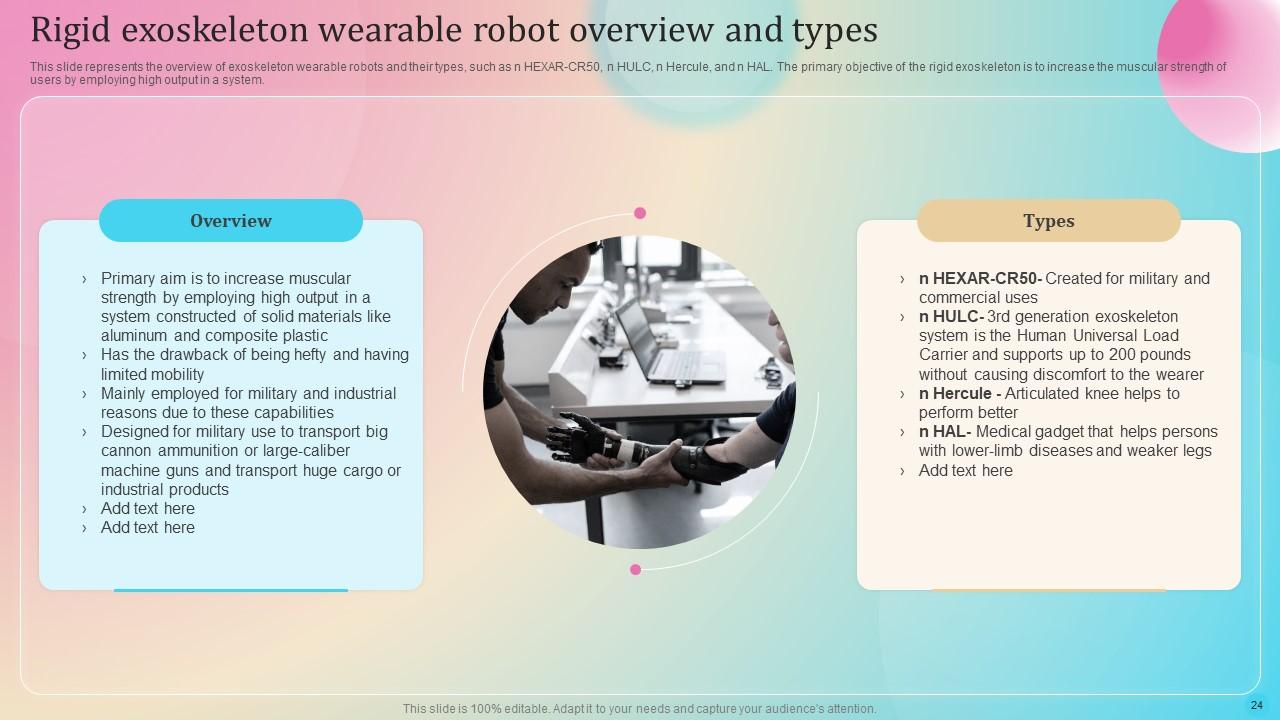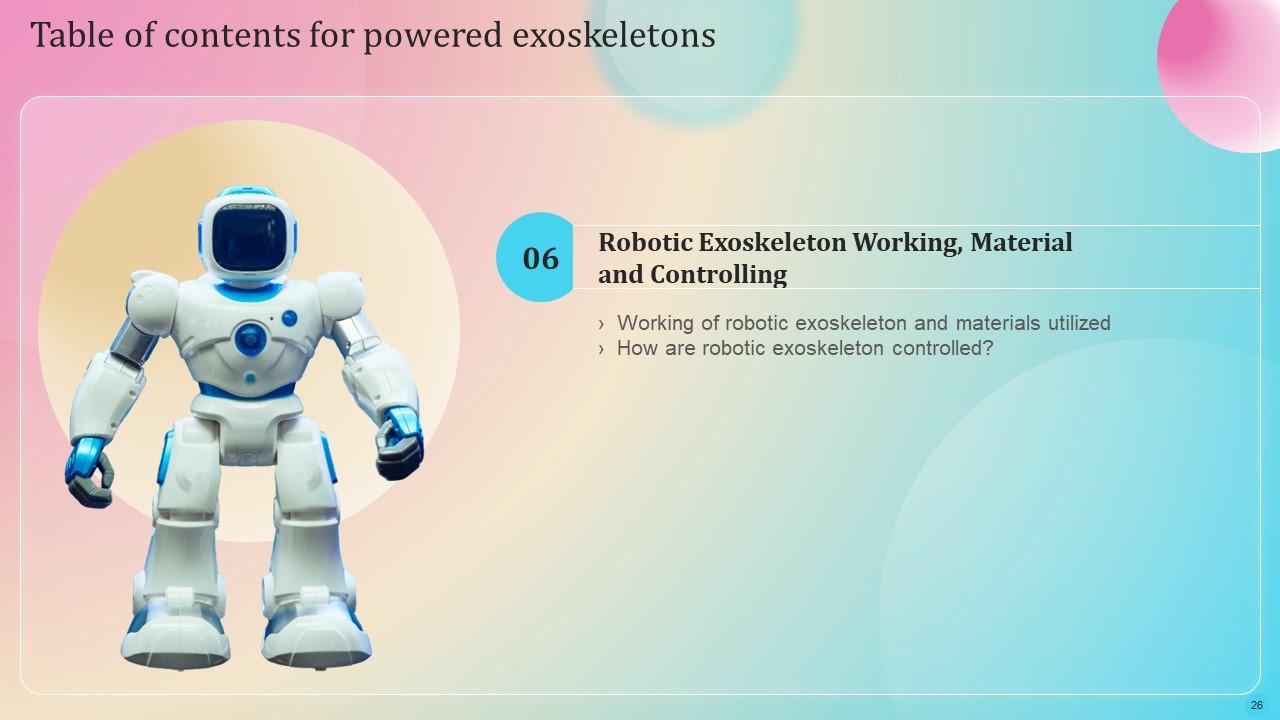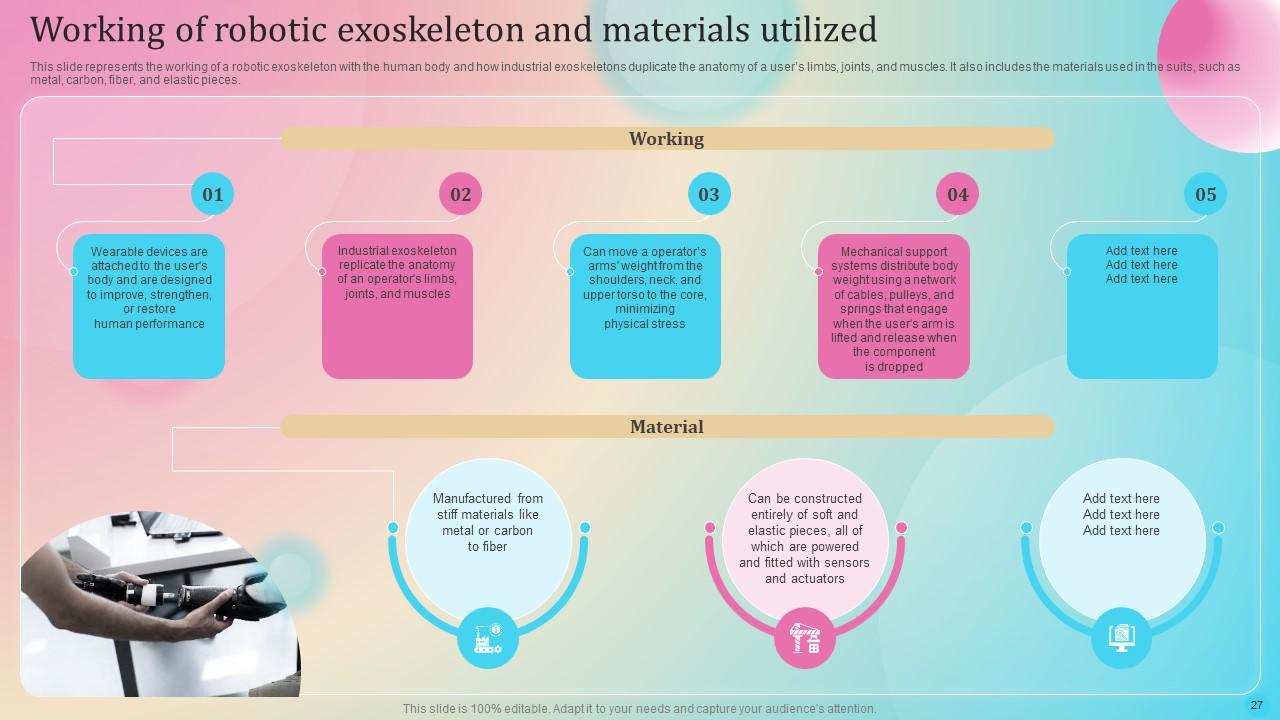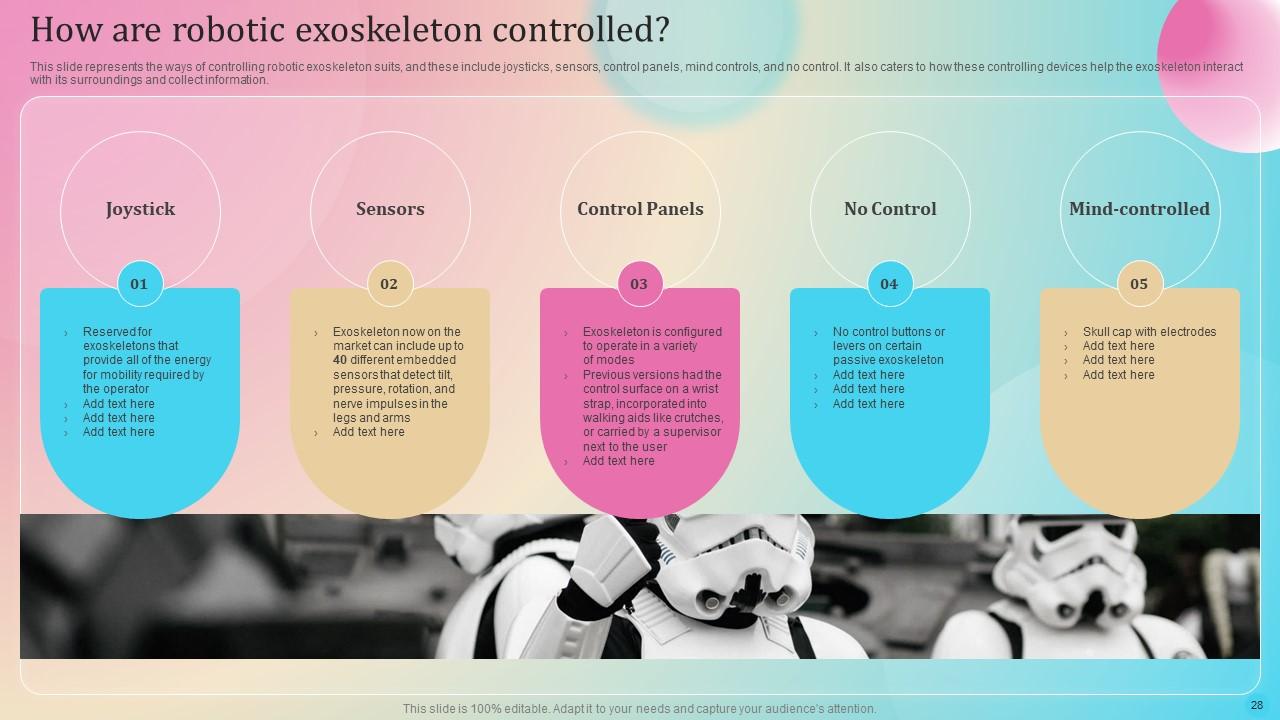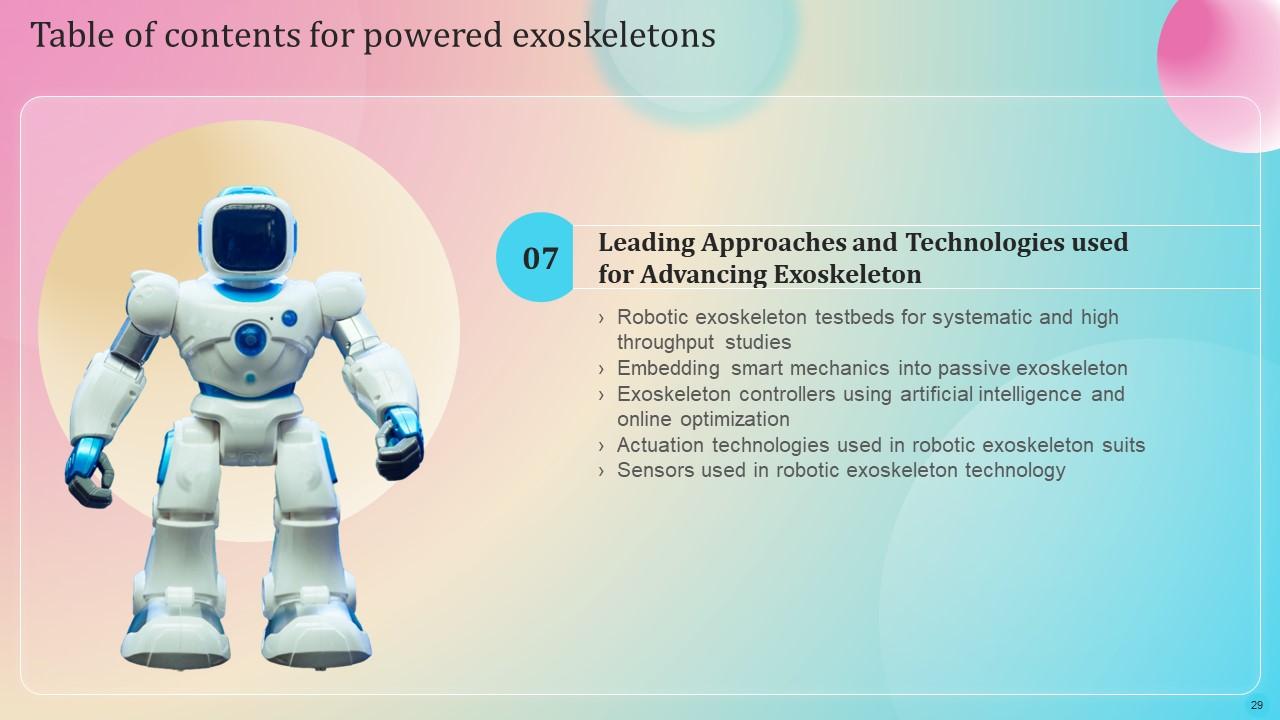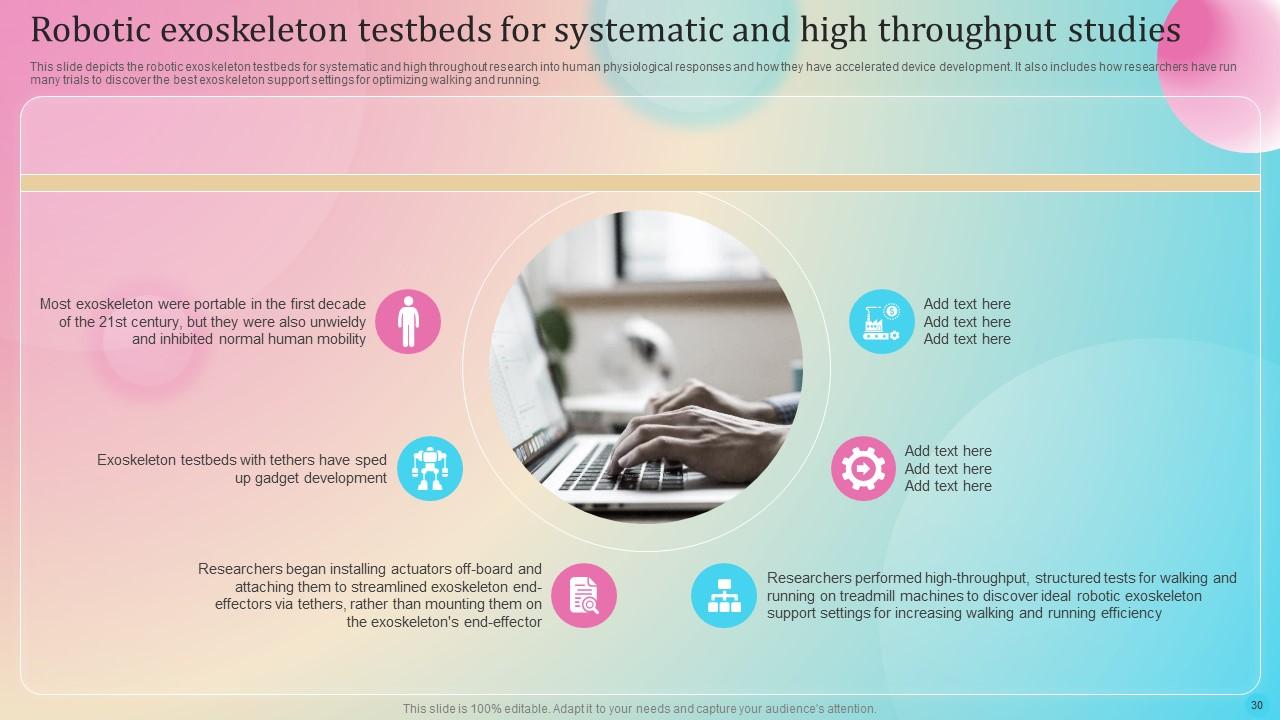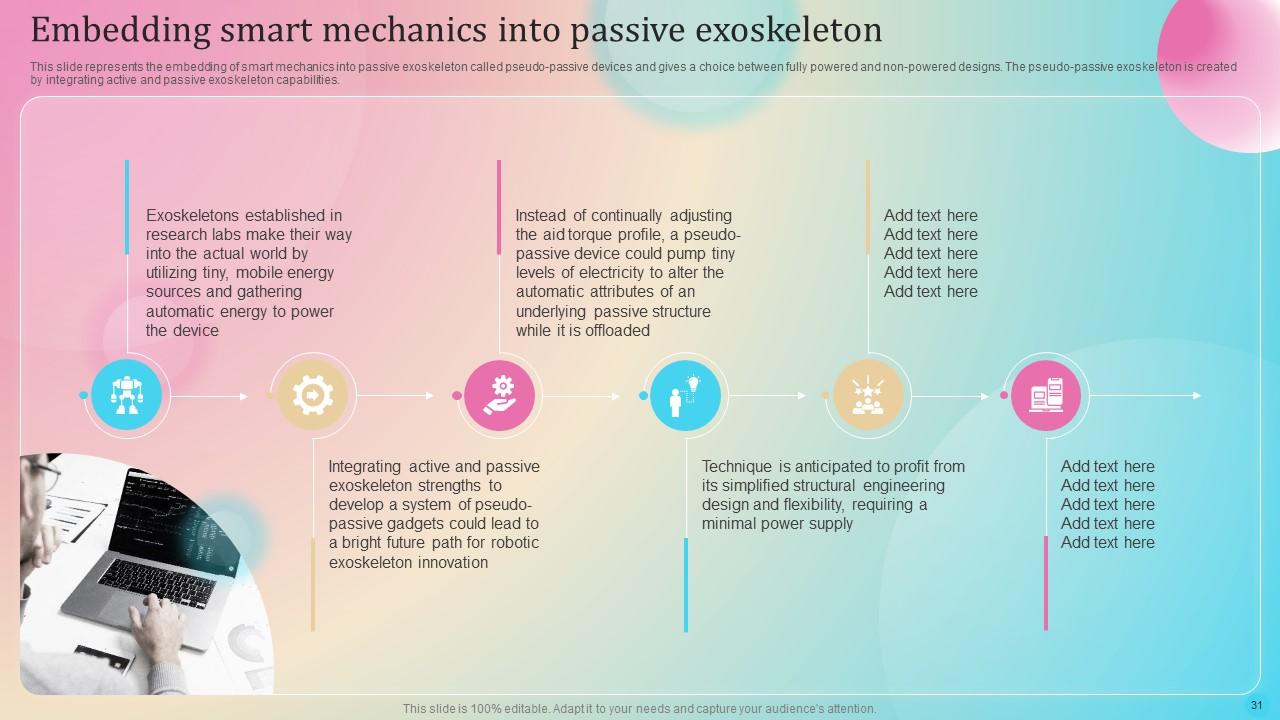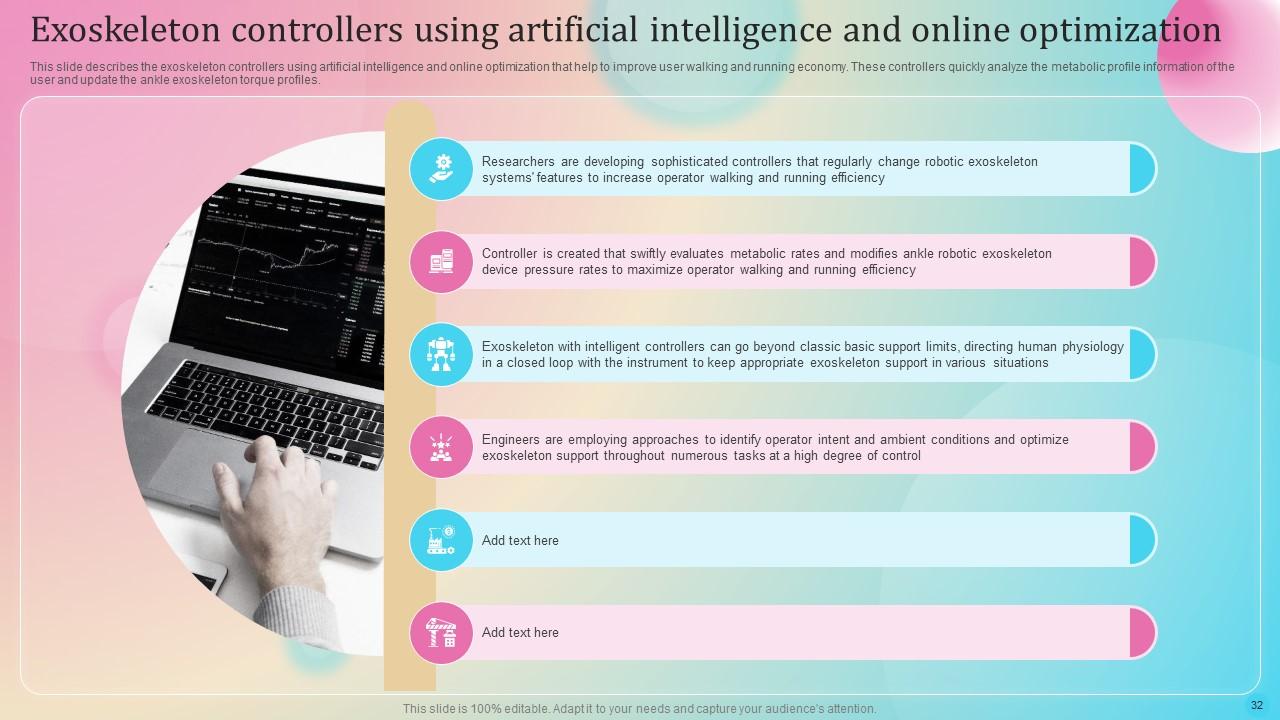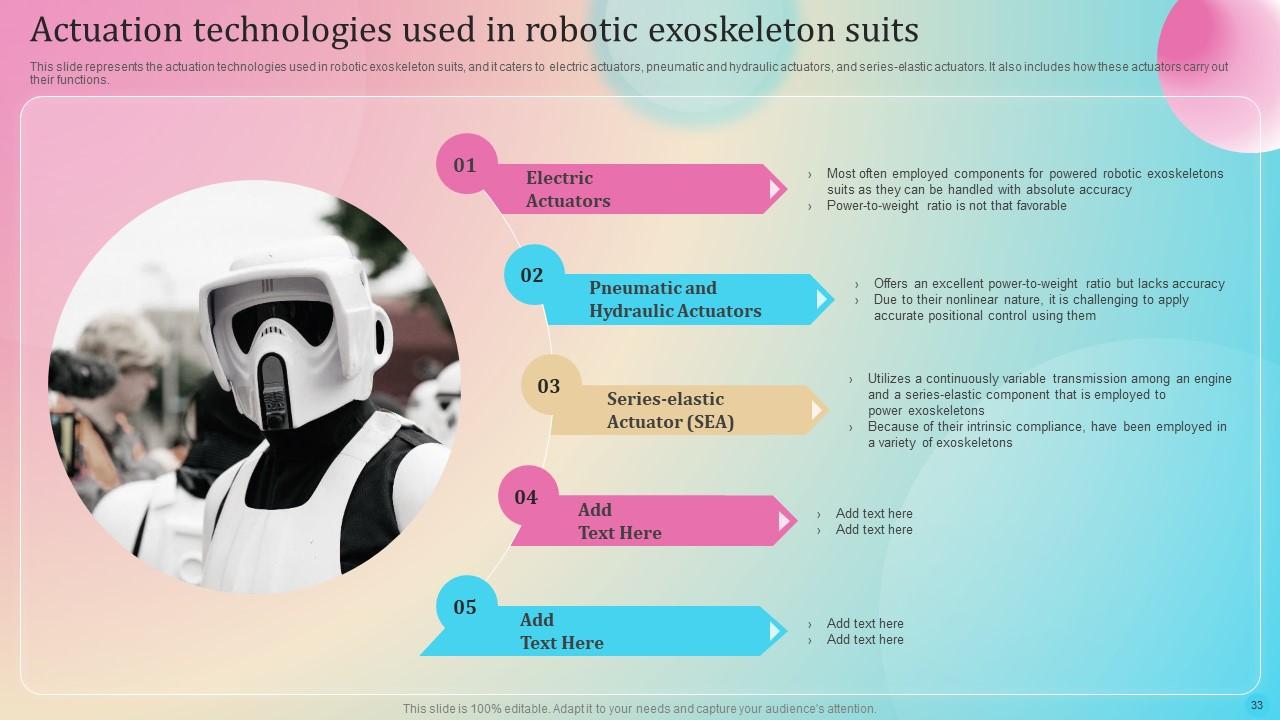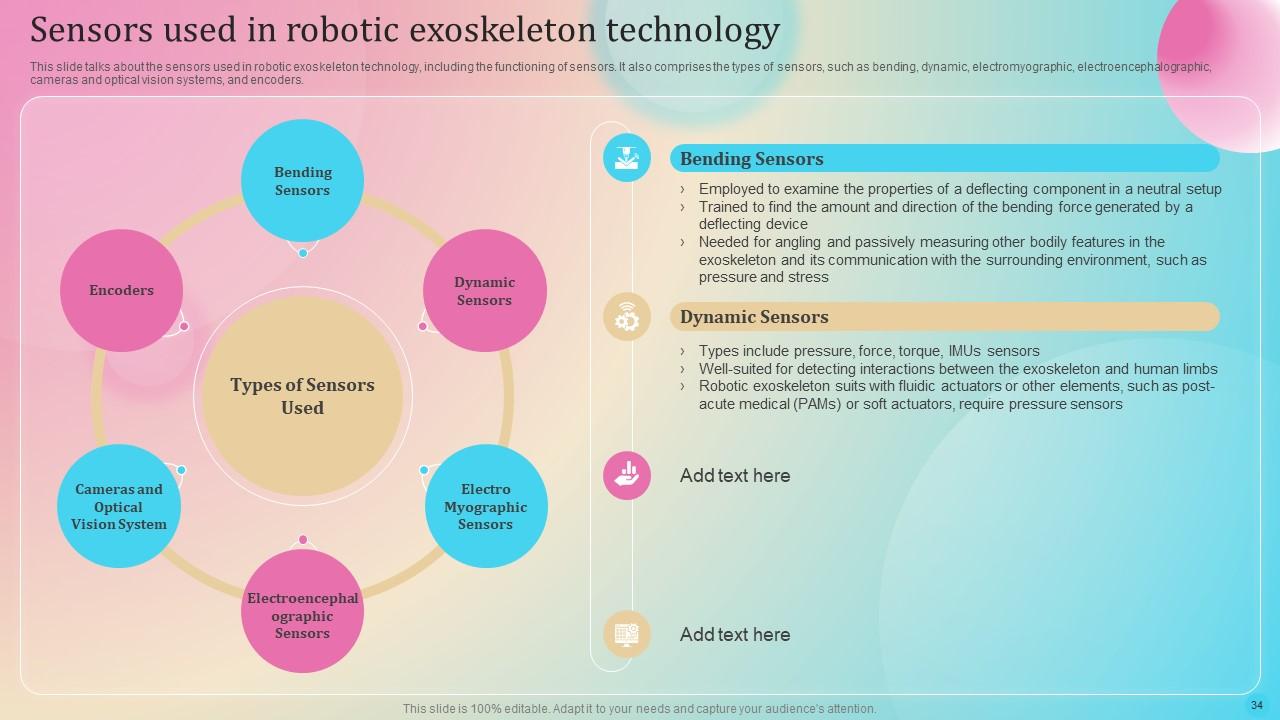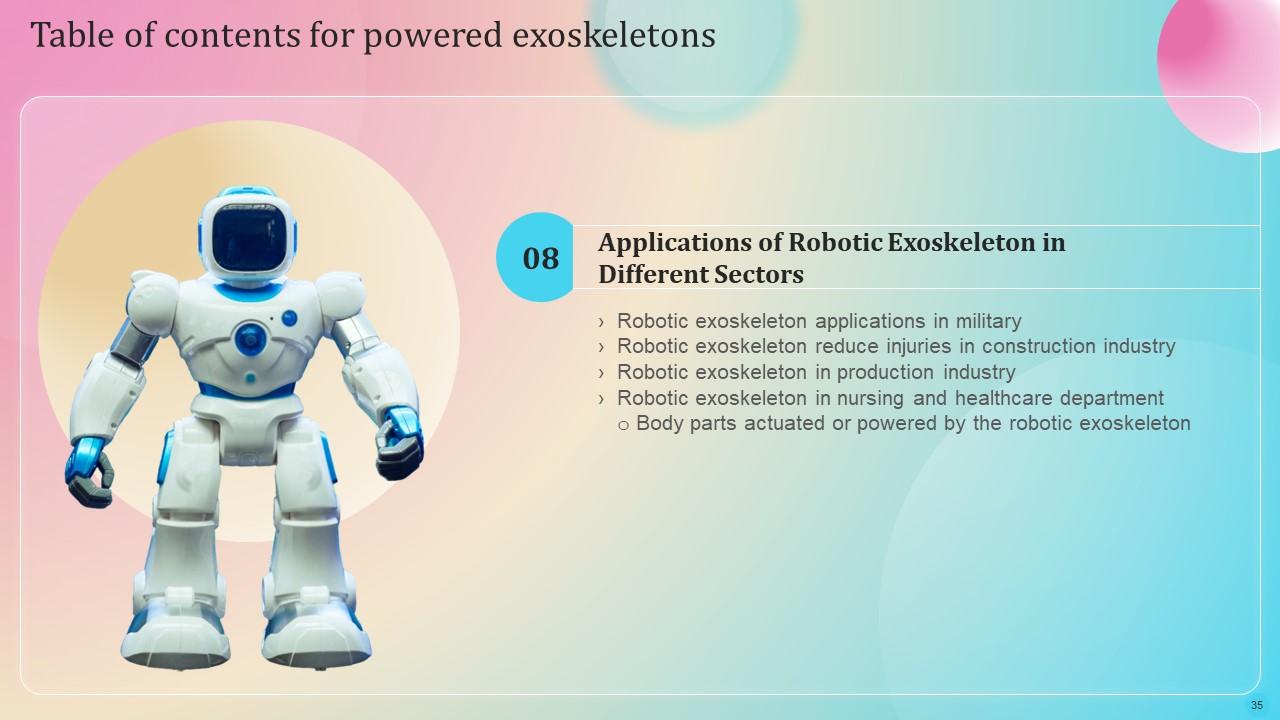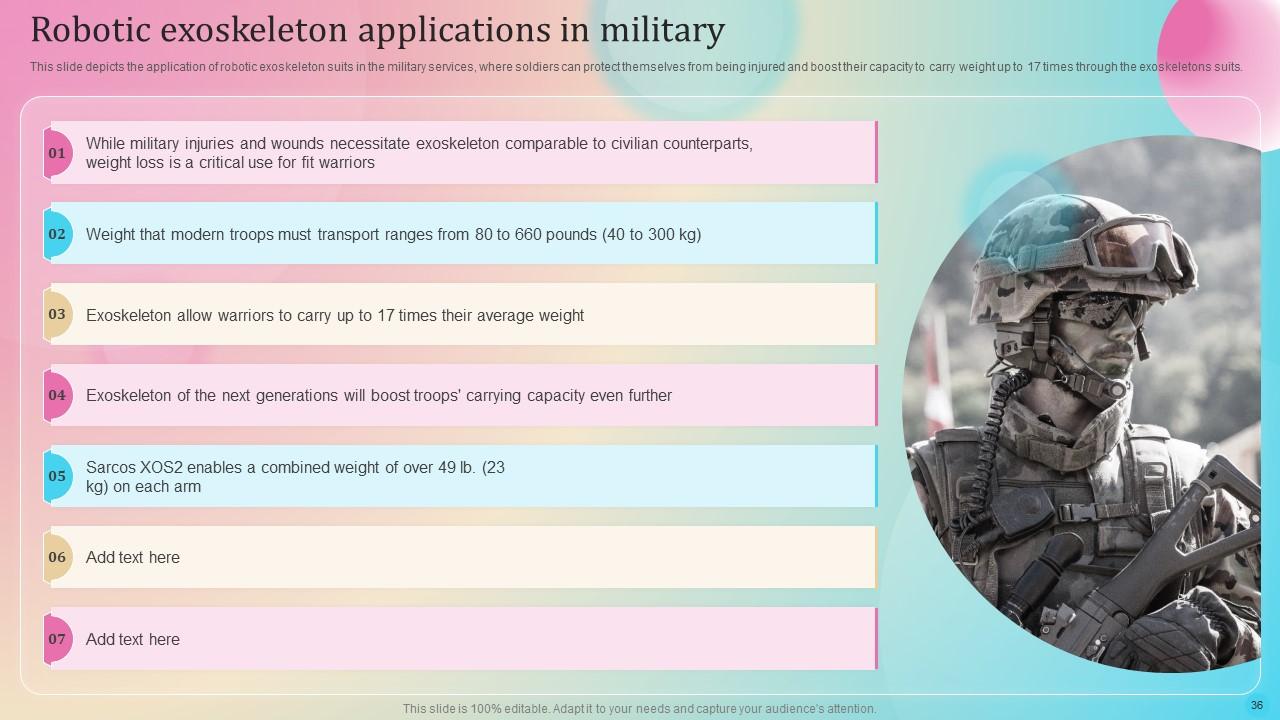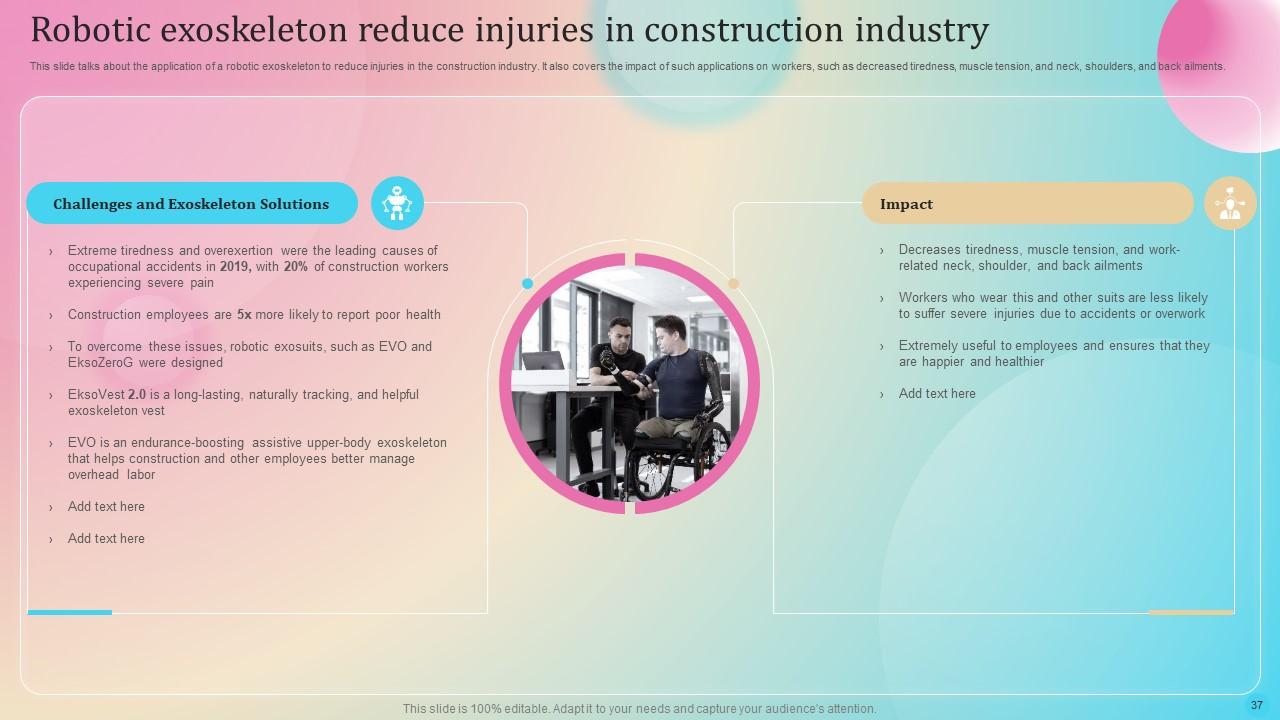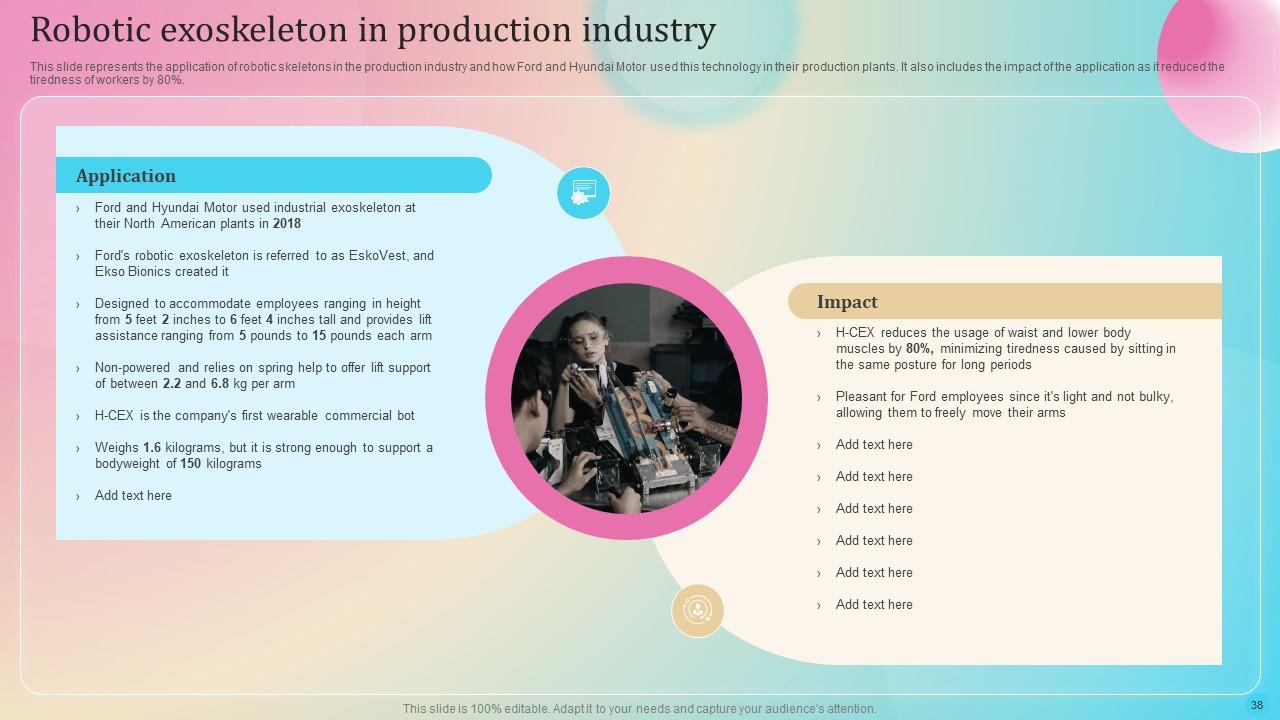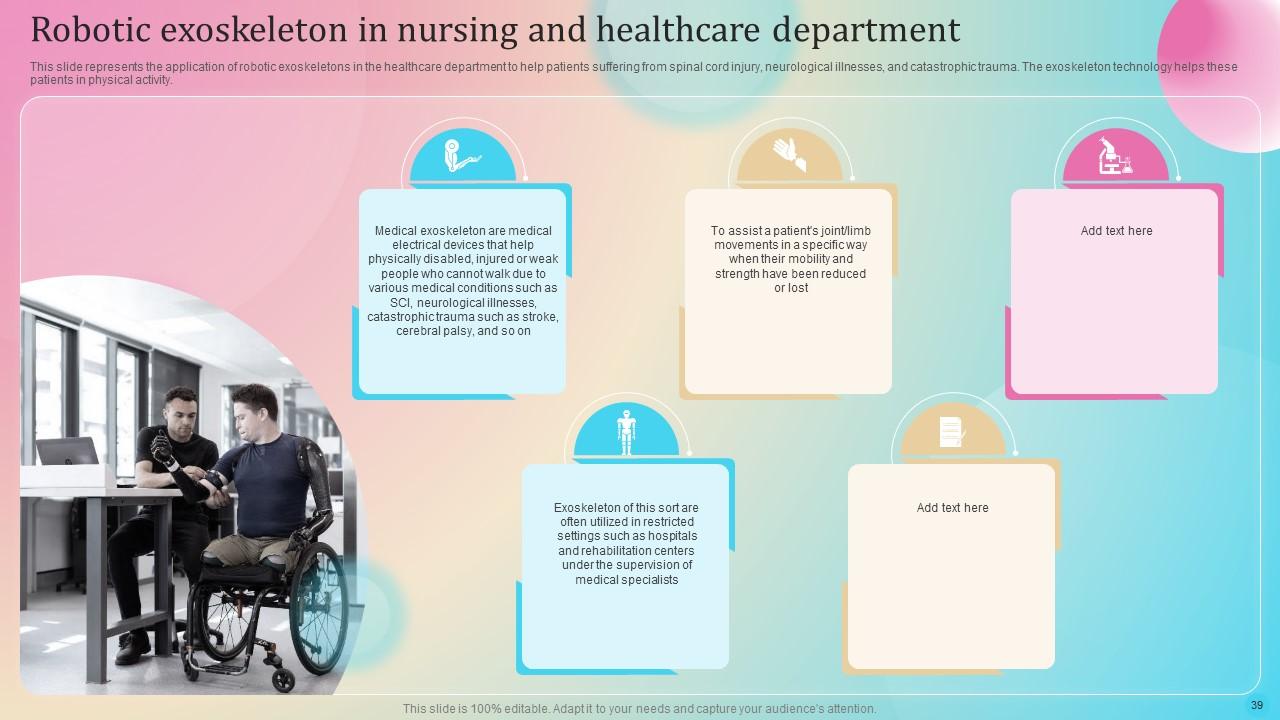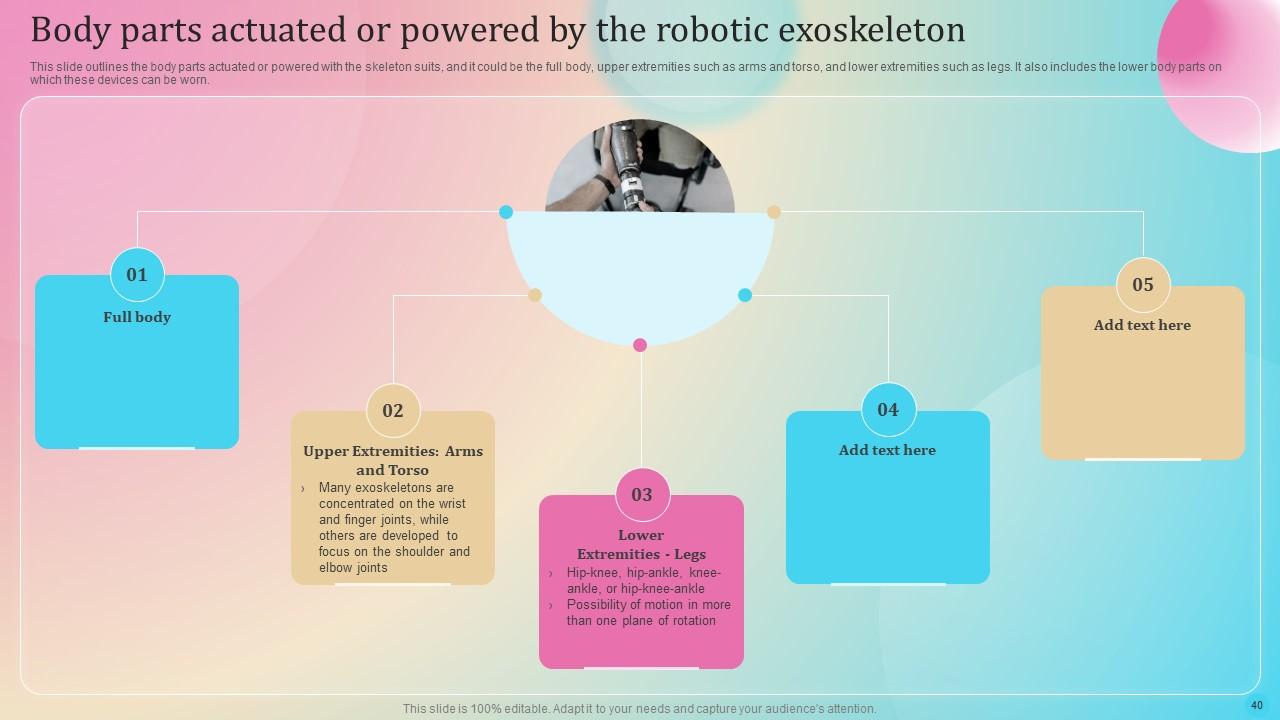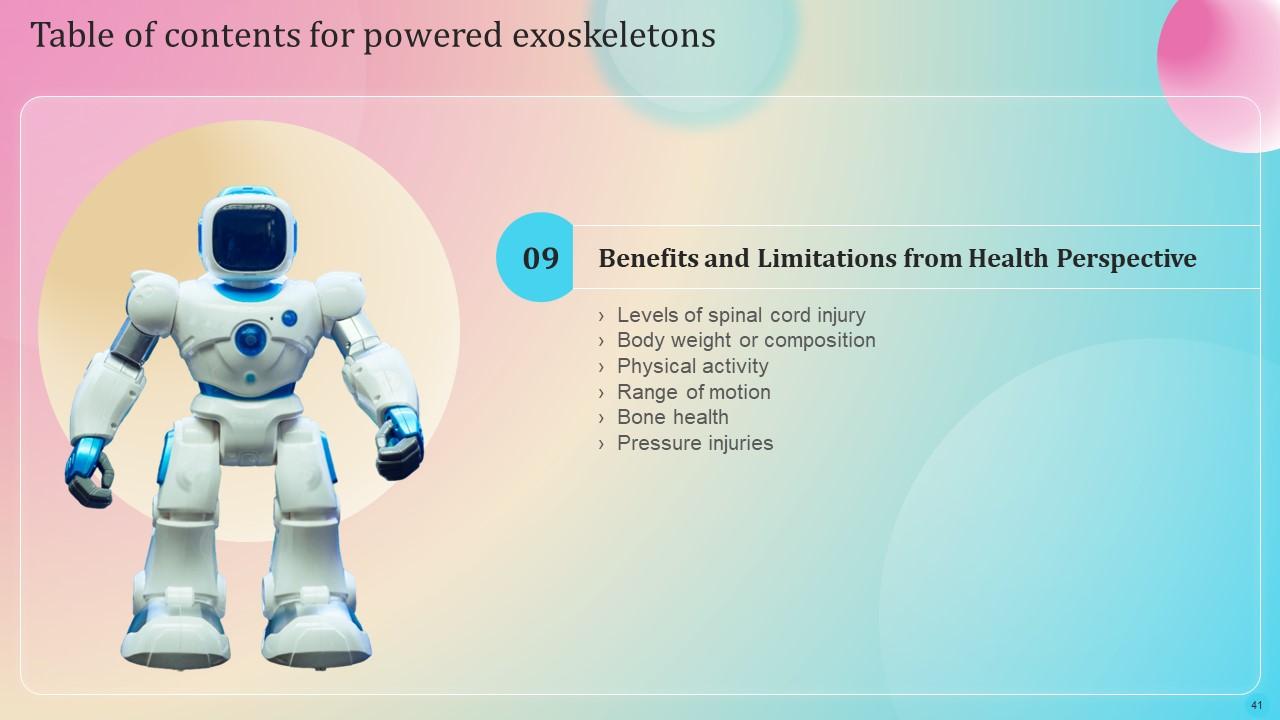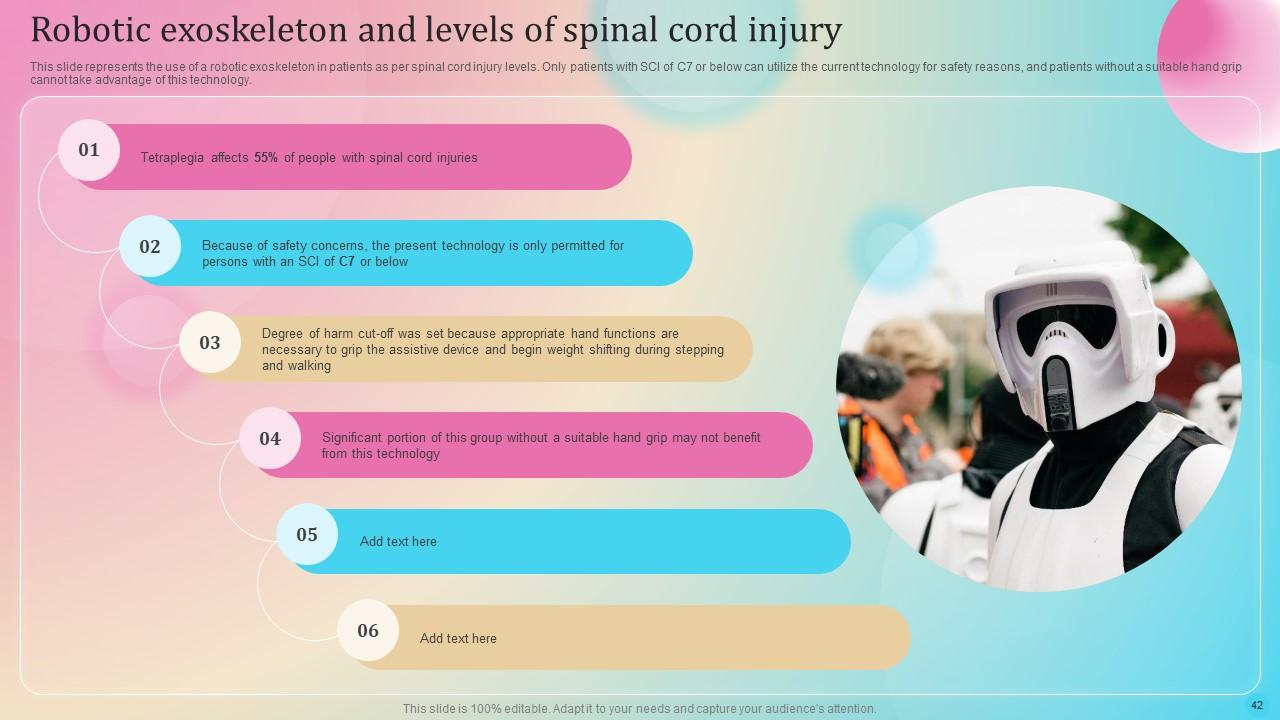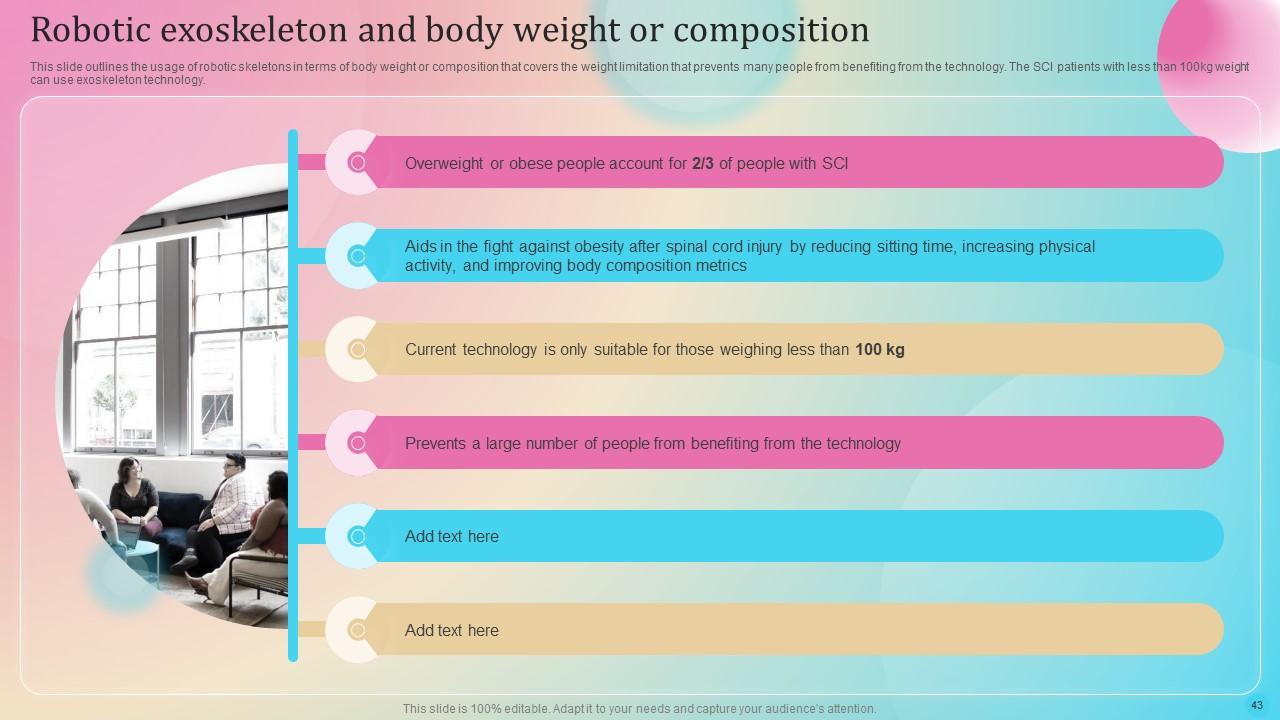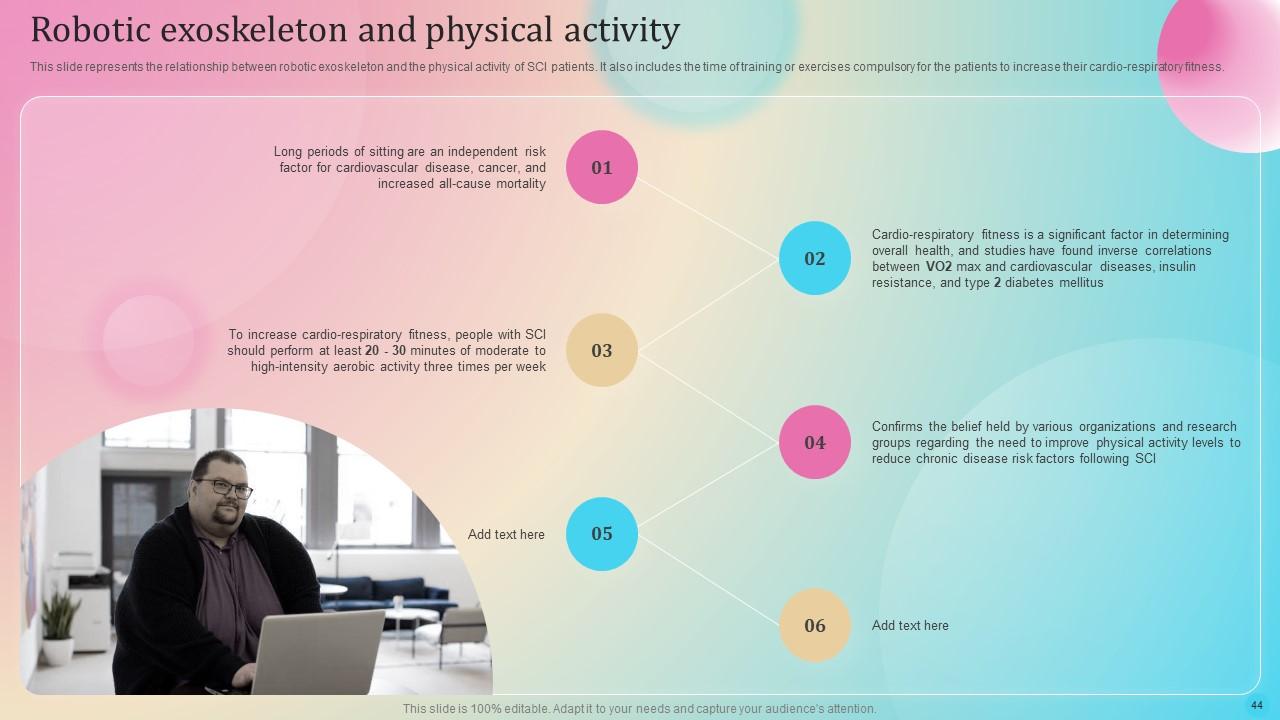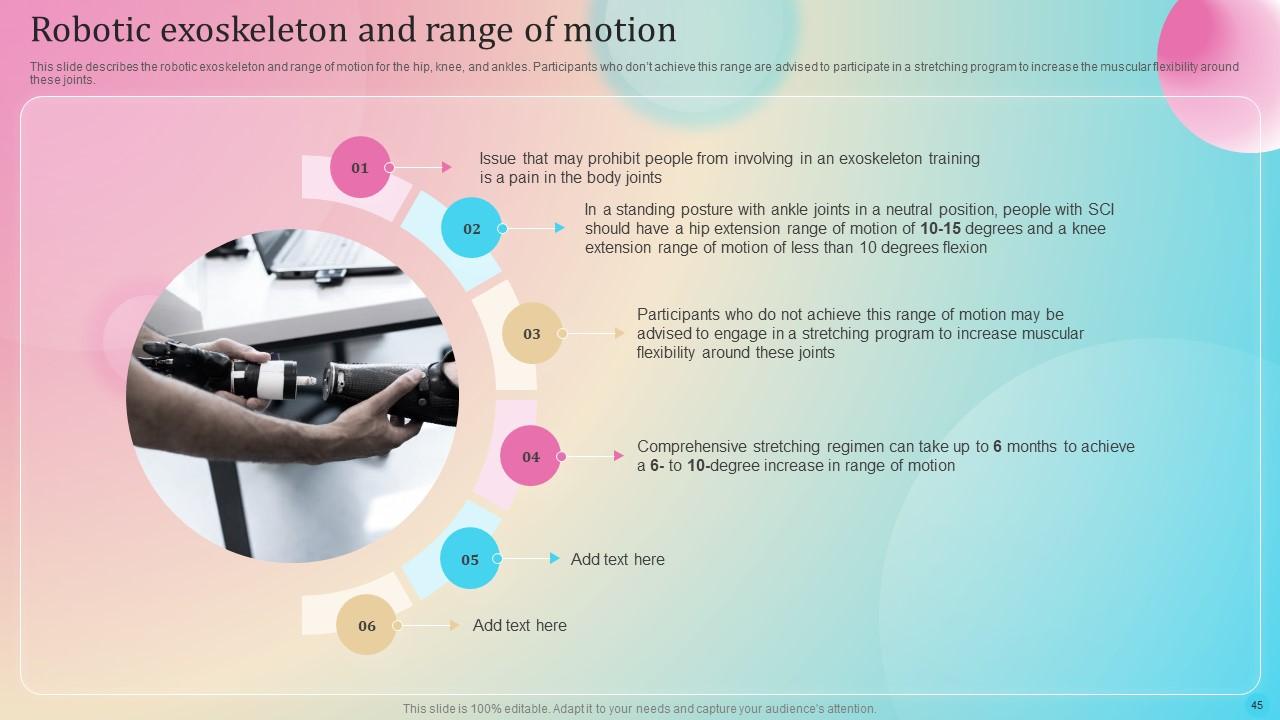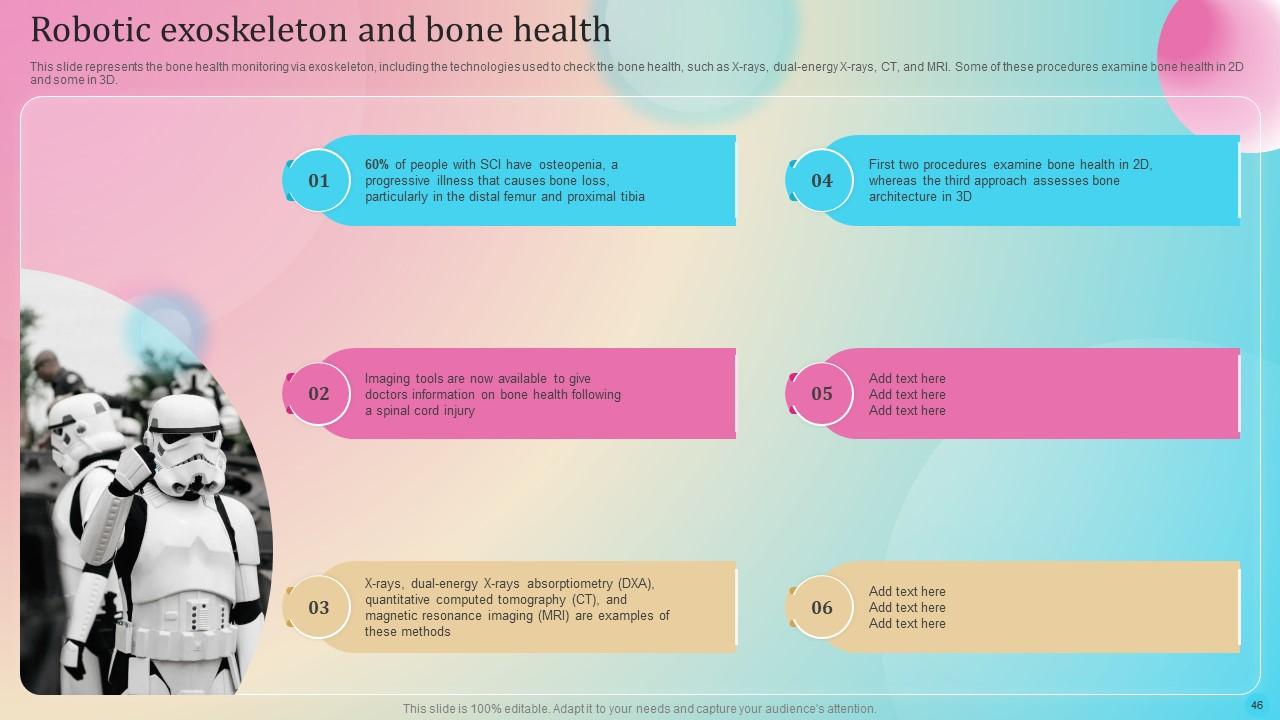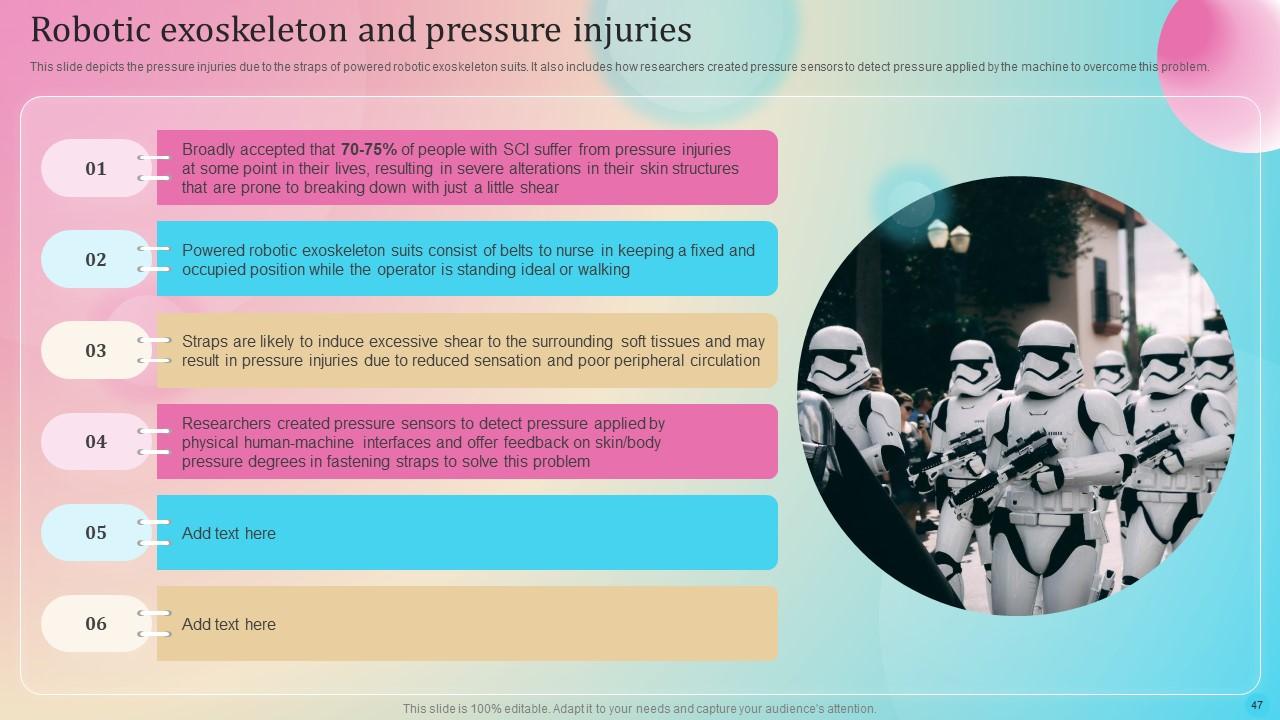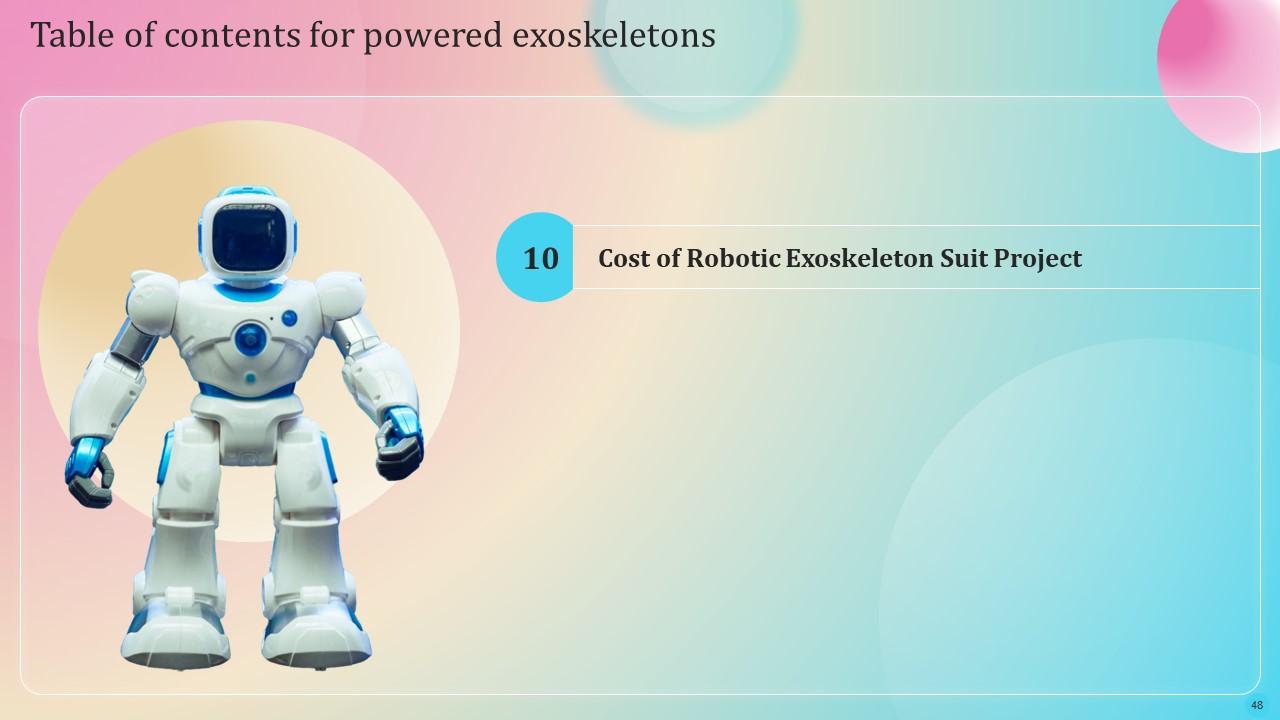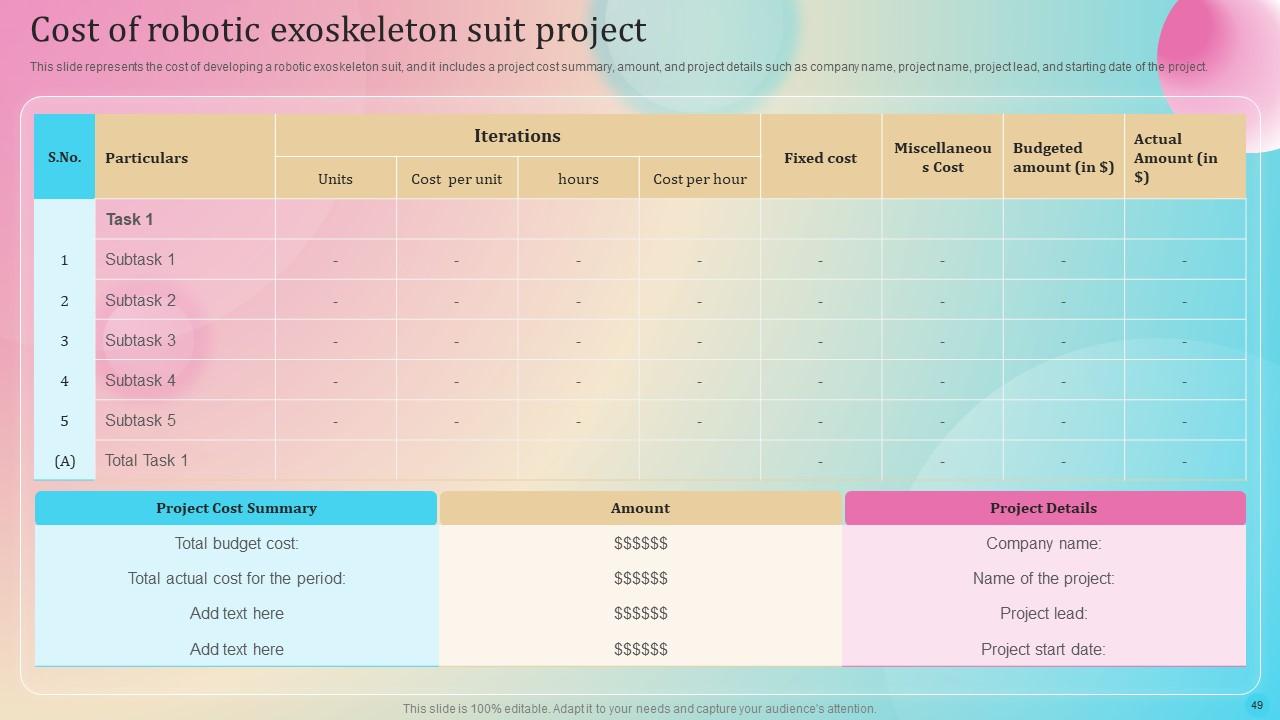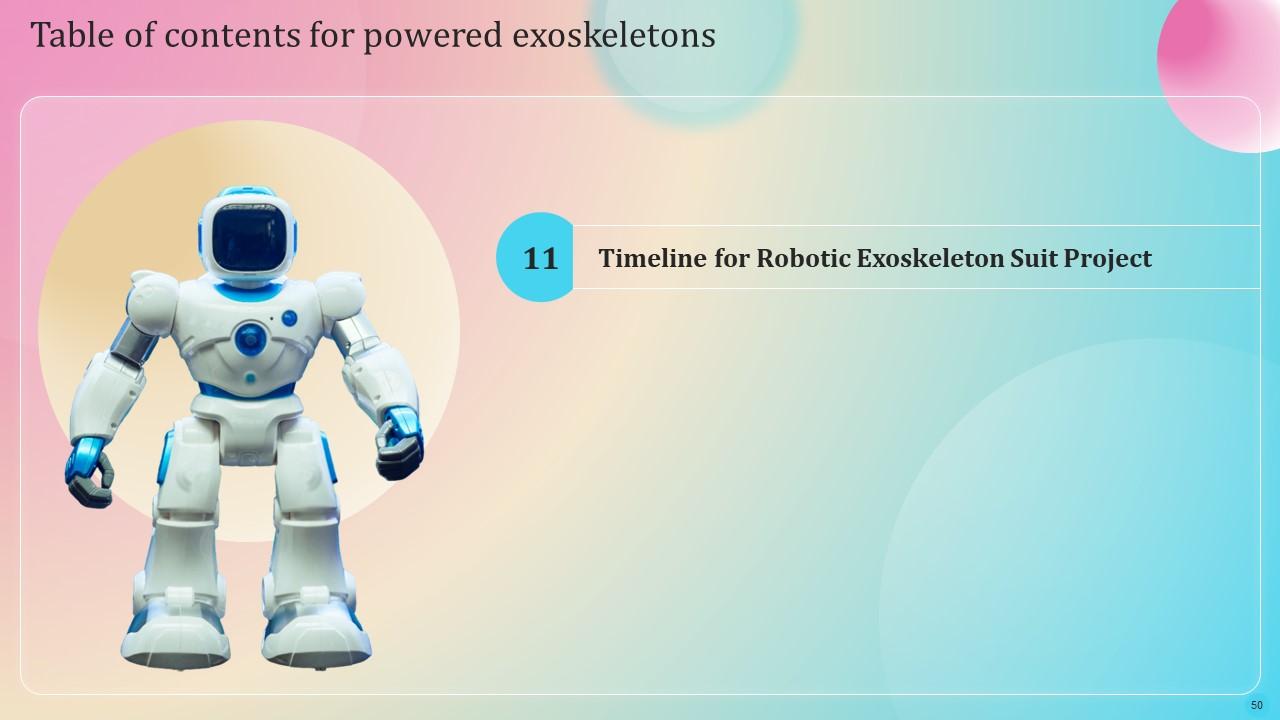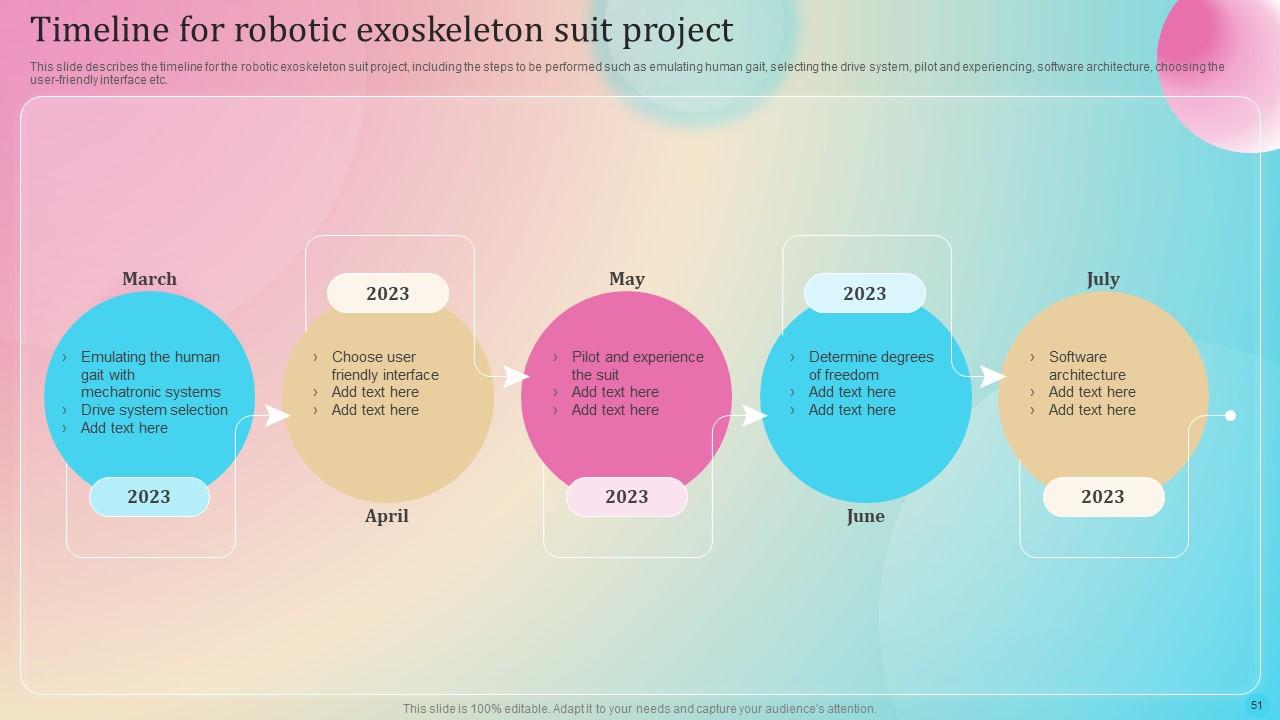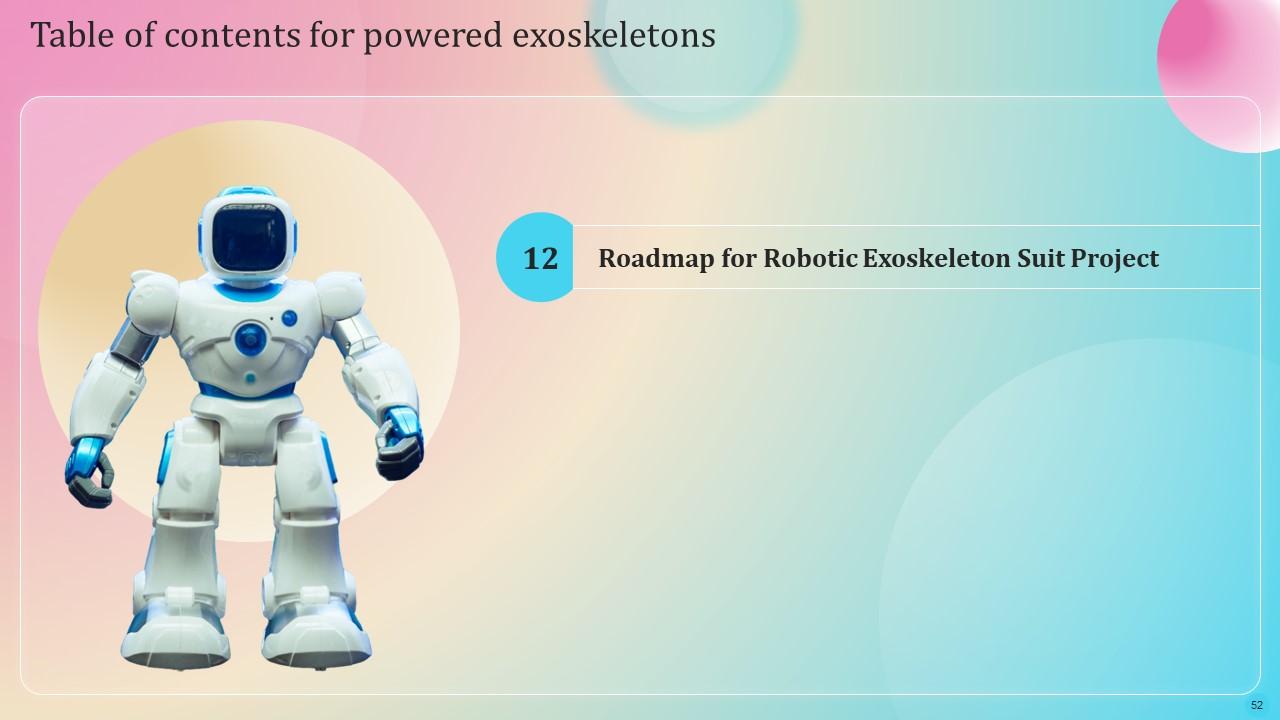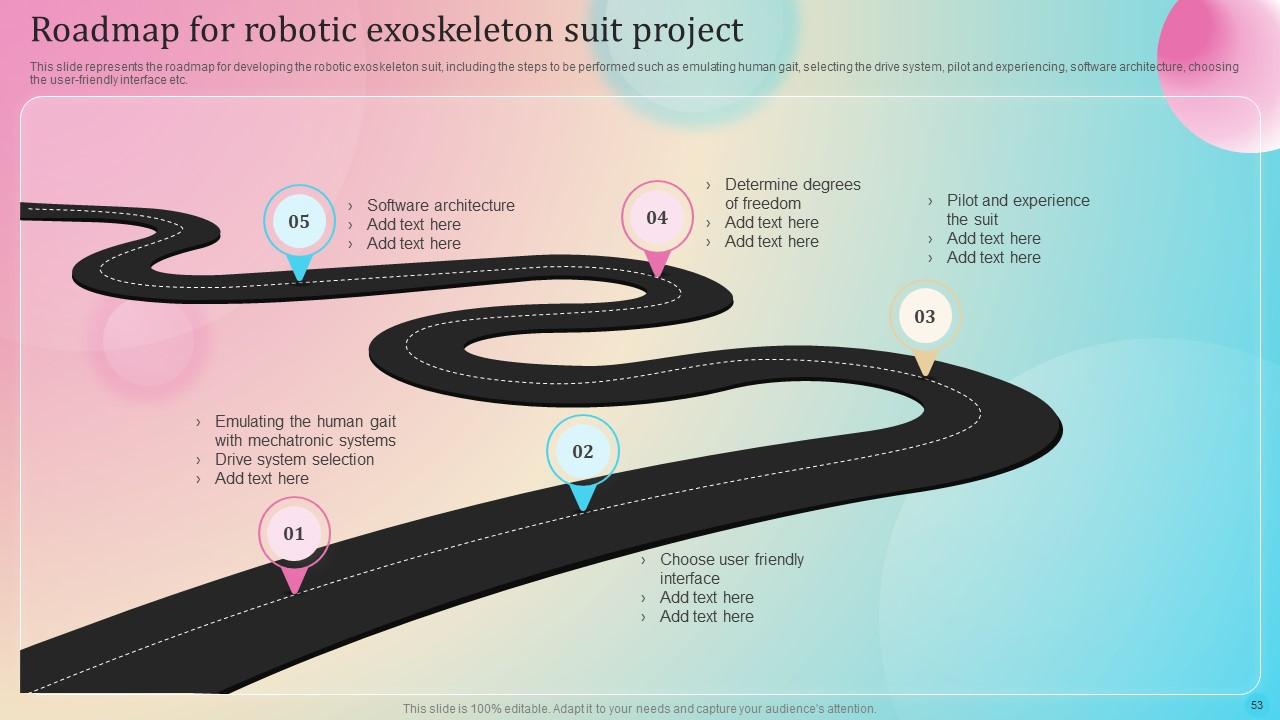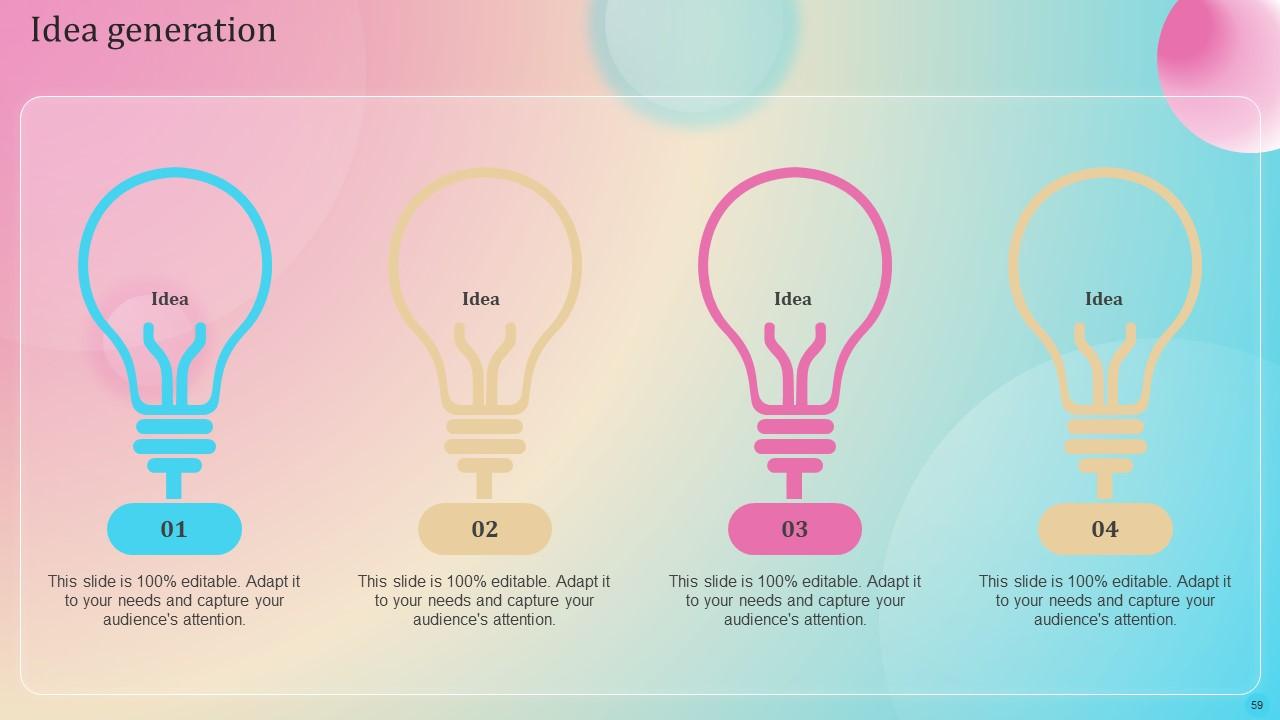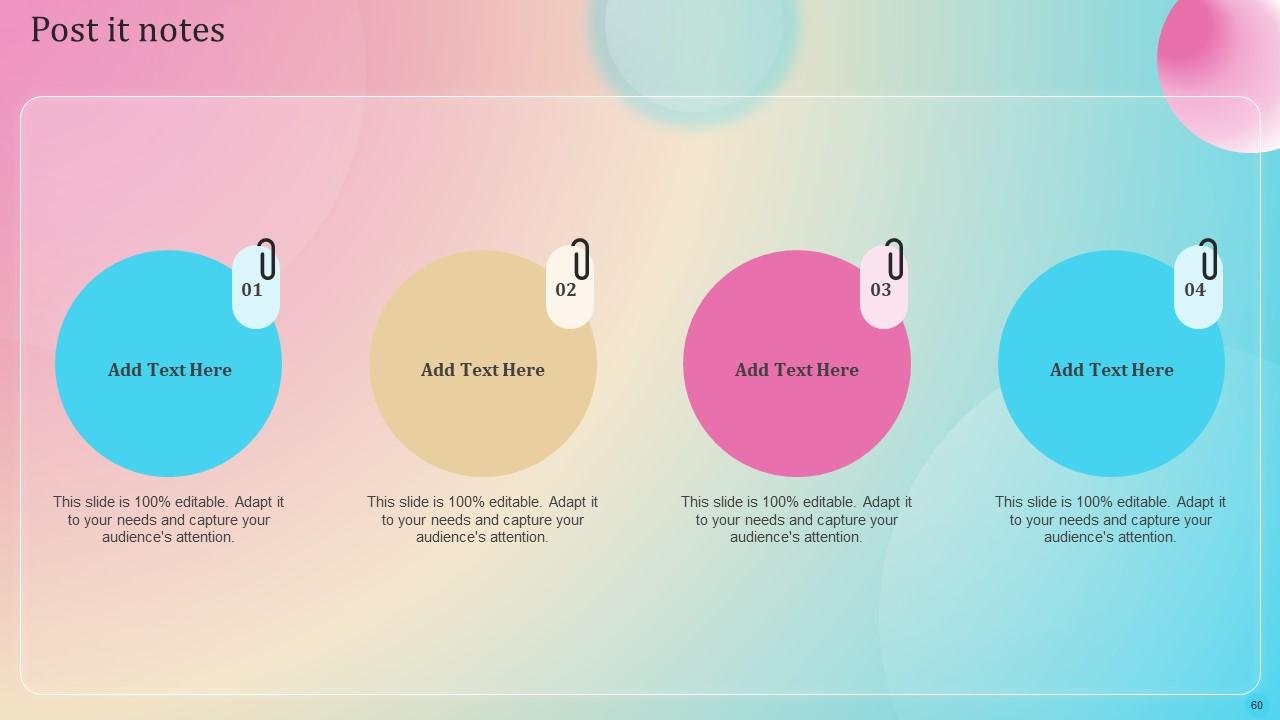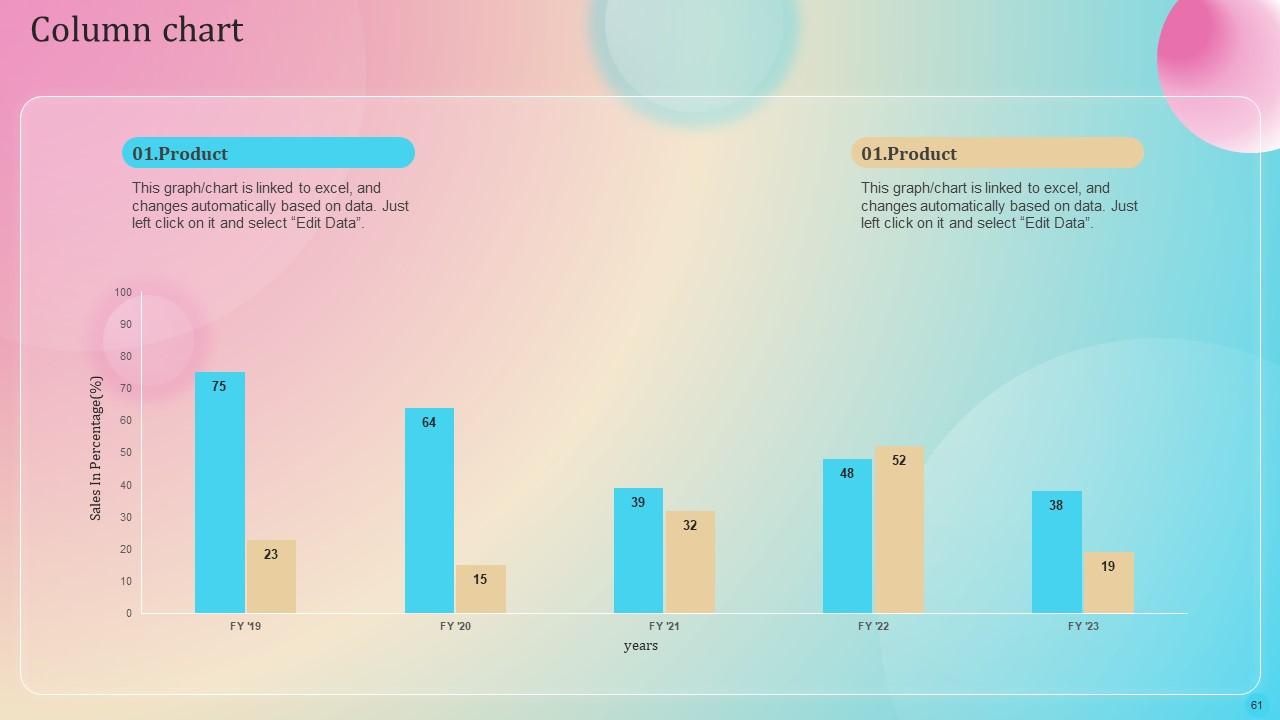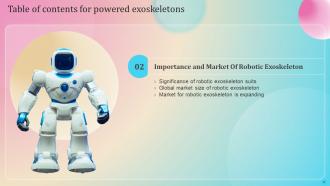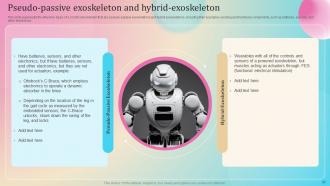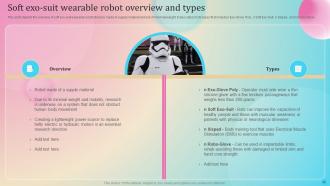Powered Exoskeletons IT Powerpoint Presentation Slides
This PowerPoint presentation Powered exoskeletons IT gives a brief idea about the robotic exoskeleton provider company, its unique values and solutions, and its importance and market share of the robotic exoskeleton. Also, it incorporates presents the overview covering the introduction, growth timeline, advantages, and disadvantages. In this Powered Exoskeleton PowerPoint Presentation, we have covered the various types of robotic exoskeletons, such as powered exoskeleton, passive exoskeleton, pseudo passive exoskeleton, hybrid exoskeleton, and artificial intelligence and smart sensors robotic exoskeleton. It also includes the exoskeleton wearable robots that are rigid and soft exo suits. In addition, this Powered Exoskeletons PPT contains the working, controlling, and materials used in robotic exoskeleton. It comprises of leading approaches and technologies for advancing exoskeletons, such as testbeds, embedding smart mechanics into passive exoskeletons, exoskeleton controllers using AI, and online optimization. Also, the Exoskeleton PPT presentation includes the applications of robotic exoskeletons in different sectors, including the military, construction and production industry, and medical departments. It also contains a special section describing the benefits and limitations from a health perspective. Furthermore, this Locomotion template caters to the cost of developing a robotic exoskeleton suit, a timeline, and a roadmap. Download our 100 percentage editable and customizable template, which is also compatible with Google Slides.
This PowerPoint presentation Powered exoskeletons IT gives a brief idea about the robotic exoskeleton provider company, its..
- Google Slides is a new FREE Presentation software from Google.
- All our content is 100% compatible with Google Slides.
- Just download our designs, and upload them to Google Slides and they will work automatically.
- Amaze your audience with SlideTeam and Google Slides.
-
Want Changes to This PPT Slide? Check out our Presentation Design Services
- WideScreen Aspect ratio is becoming a very popular format. When you download this product, the downloaded ZIP will contain this product in both standard and widescreen format.
-

- Some older products that we have may only be in standard format, but they can easily be converted to widescreen.
- To do this, please open the SlideTeam product in Powerpoint, and go to
- Design ( On the top bar) -> Page Setup -> and select "On-screen Show (16:9)” in the drop down for "Slides Sized for".
- The slide or theme will change to widescreen, and all graphics will adjust automatically. You can similarly convert our content to any other desired screen aspect ratio.
Compatible With Google Slides

Get This In WideScreen
You must be logged in to download this presentation.
PowerPoint presentation slides
Enthrall your audience with this Powered Exoskeletons IT Powerpoint Presentation Slides. Increase your presentation threshold by deploying this well-crafted template. It acts as a great communication tool due to its well-researched content. It also contains stylized icons, graphics, visuals etc, which make it an immediate attention-grabber. Comprising sixty two slides, this complete deck is all you need to get noticed. All the slides and their content can be altered to suit your unique business setting. Not only that, other components and graphics can also be modified to add personal touches to this prefabricated set.
People who downloaded this PowerPoint presentation also viewed the following :
Content of this Powerpoint Presentation
Slide 1: This slide displays the title Powered Exoskeletons (IT).
Slide 2: This slide displays the title AGENDA.
Slide 3: This slide exhibit table of content.
Slide 4: This slide exhibit table of content- About Us.
Slide 5: This slide represents the overview of the robotic exoskeleton manufacturing company.
Slide 6: This slide depicts our company's unique values and solutions that include affordable prices, a combination of EPW, FEX, artificial intelligence.
Slide 7: This slide describes the robotic exoskeleton representative team of the manufacturing company.
Slide 8: This slide exhibit table of content- Importance and Market Of Robotic Exoskeleton.
Slide 9: This slide talks about the importance of robotic exoskeleton suits by defining the achievements of the technology.
Slide 10: This slide represents the global market size of robotic exoskeletons from 2015 to 2025.
Slide 11: This slide talks about the growing robotic exoskeleton market from 2021 to 2023.
Slide 12: This slide exhibit table of content- Robotic Exoskeleton Overview.
Slide 13: This slide represents the overview of robotic exoskeleton that are wearable robotics systems and widely used in healthcare departments and households.
Slide 14: This slide depicts the generic architecture of a robotic exoskeleton.
Slide 15: This slide represents the timeline for the growth of robotic exoskeletons in recent years from 2019 to 2023 by describing the total number of exoskeletons models.
Slide 16: This slide represents the advantages of a robotic exoskeleton, including worker safety in dangerous situations, helping in the healthcare industry.
Slide 17: This slide discusses the disadvantages of robotic exoskeleton suits and includes heavy and bulky, speed issues, handgrip, pressure injuries.
Slide 18: This slide exhibit table of content- Robotic Exoskeleton Types Offered.
Slide 19: This slide depicts the powered exoskeleton type of robotic exoskeleton and the hardware components used in it.
Slide 20: This slide describes the passive type of robotic exoskeletons that boost a user’s mobility with springs or other sources of motor force.
Slide 21: This slide represents the other two types of a robotic exoskeleton that are pseudo-passive exoskeletons and hybrid exoskeletons.
Slide 22: This slide talks about the artificial intelligence and smart sensors robotic exoskeleton suit, where user information is collected by sensors and interpreted by AI.
Slide 23: This slide exhibit table of content- Exoskeleton Wearable Robot.
Slide 24: This slide represents the overview of exoskeleton wearable robots and their types, such as n HEXAR-CR50, n HULC, n Hercule, and n HAL.
Slide 25: This slide depicts the overview of soft exo-suit wearable robots that are made of supple material and are of minimal weight.
Slide 26: This slide exhibit table of content- Robotic Exoskeleton Working, Material and Controlling.
Slide 27: This slide represents the working of a robotic exoskeleton with the human body.
Slide 28: This slide represents the ways of controlling robotic exoskeleton suits, and these include joysticks, sensors, control panels, mind controls, and no control.
Slide 29: This slide exhibit table of content- Leading Approaches and Technologies used for Advancing Exoskeleton.
Slide 30: This slide depicts the robotic exoskeleton testbeds for systematic and high throughout research into human physiological responses.
Slide 31: This slide represents the embedding of smart mechanics into passive exoskeleton called pseudo-passive devices.
Slide 32: This slide describes the exoskeleton controllers using artificial intelligence and online optimization that help to improve user walking and running economy.
Slide 33: This slide represents the actuation technologies used in robotic exoskeleton suits.
Slide 34: This slide talks about the sensors used in robotic exoskeleton technology, including the functioning of sensors.
Slide 35: This slide exhibit table of content- Applications of Robotic Exoskeleton in Different Sectors.
Slide 36: This slide depicts the application of robotic exoskeleton suits in the military services.
Slide 37: This slide talks about the application of a robotic exoskeleton to reduce injuries in the construction industry.
Slide 38: This slide represents the application of robotic skeletons in the production industry and how Ford and Hyundai Motor used this technology in their production plants.
Slide 39: This slide represents the application of robotic exoskeletons in the healthcare department.
Slide 40: This slide outlines the body parts actuated or powered with the skeleton suits, and it could be the full body, upper extremities.
Slide 41: This slide exhibit table of content- Benefits and Limitations from Health Perspective.
Slide 42: This slide represents the use of a robotic exoskeleton in patients as per spinal cord injury levels.
Slide 43: This slide outlines the usage of robotic skeletons in terms of body weight or composition.
Slide 44: This slide represents the relationship between robotic exoskeleton and the physical activity of SCI patients.
Slide 45: This slide describes the robotic exoskeleton and range of motion for the hip, knee, and ankles.
Slide 46: This slide represents the bone health monitoring via exoskeleton, including the technologies used to check the bone health.
Slide 47: This slide depicts the pressure injuries due to the straps of powered robotic exoskeleton suits.
Slide 48: This slide showcase the title Cost of Robotic Exoskeleton Suit Project.
Slide 49: This slide represents the cost of developing a robotic exoskeleton suit.
Slide 50: This slide exhibit table of content- Timeline for Robotic Exoskeleton Suit Project.
Slide 51: This slide describes the timeline for the robotic exoskeleton suit project.
Slide 52: This slide presents the title Roadmap for Robotic Exoskeleton Suit Project
Slide 53: This slide represents the roadmap for developing the robotic exoskeleton suit.
Slide 54: This is the icons slide.
Slide 55: This slide presents title for additional slides.
Slide 56: This slide presents your company's vision, mission and goals.
Slide 57: This slide presents the title About us.
Slide 58: This slide shows details of team members like name, designation, etc.
Slide 59: This slide exhibit Idea generation.
Slide 60: This slide depicts posts for past experiences of clients.
Slide 61: This slide showcase Column chart for different products.
Slide 62: This is thank you slide & contains contact details of company like office address, phone no., etc.
Powered Exoskeletons IT Powerpoint Presentation Slides with all 67 slides:
Use our Powered Exoskeletons IT Powerpoint Presentation Slides to effectively help you save your valuable time. They are readymade to fit into any presentation structure.
FAQs
Robotic exoskeletons have many advantages, such as enhancing human strength and endurance, improving safety in hazardous situations, and increasing productivity and efficiency in different sectors like healthcare and manufacturing.
Although robotic exoskeletons offer several benefits, there are some disadvantages as well. The suits can be heavy and bulky, leading to discomfort and mobility issues. Speed can also be a problem, and there could be pressure injuries due to the straps.
There are several types of robotic exoskeletons available, including powered exoskeletons, passive exoskeletons, pseudo-passive exoskeletons, and hybrid exoskeletons. There are also exoskeleton wearable robots, soft exo-suits, and exoskeletons for specific body parts like the upper extremities.
Robotic exoskeletons have many applications in various industries, including the military, construction, production, and healthcare. They can help to reduce injuries and improve worker safety, and they are useful for rehabilitation and assisting people with disabilities or injuries.
The cost of developing a robotic exoskeleton suit varies depending on the complexity and features of the suit. However, it is generally quite expensive, with estimates ranging from tens of thousands to millions of dollars. The cost includes research and development, materials, manufacturing, and testing.
-
Very well designed and informative templates.
-
Every time I ask for something out-of-the-box from them and they never fail in delivering that. No words for their excellence!



